Toyota Hilux pickup review (2023)
Tough, versatile and comfortable - and now available with 204hp
PROS
- Very tough and durable
- Quiet, refined and now with up to 204hp
- Up to 10-year warranty
- Comfortable ride for leaf spring suspension
- 3.5t towing capacity (on some models)
CONS
- Original engine lacks power
- Rivals are more fuel efficient
- Expensive to buy
- Alarm not standard on any model
- Max torque limited to the auto
Summary
The Toyota Hilux is one of the world's best known pickup trucks. First introduced way back in 1968, it quickly established an outstanding reputation as a durable workhorse and capable off-roader. This 2023 Toyota Hilux review covers the eighth-generation model, which was launched in 2016 and received a major facelift in late 2020.
This latest Hilux brings a substantial increase in safety equipment, improved comfort and even better off-road characteristics - with the 2020 update adding a new look, engineering changes that further improve the driving experience, and a brand new 2.8-litre engine with a socking-great 204hp and 500Nm of torque.
Toyota kicked off 2022 by announcing a new range-topping model called the Hilux GR Sport, with upgraded looks and suspension. It slid out a few additions to the spec list, too, with the most notable being a Panoramic View Monitor camera that allows you to get a birds-eye view of the car when parking. An auto-dimming rear-view mirror, dual zone air conditioning and changes to the DCM (Data Communication Module) that allows emergency calling, service reminders and remote fault diagnosis.
These updates help the Toyota to a place where we have named it the best in class. It might not be surrounded by as many rivals these days, but this doesn't stop it being an excellent option and it is the 2023 Parkers New Car Awards winner of the Best Pickup category.
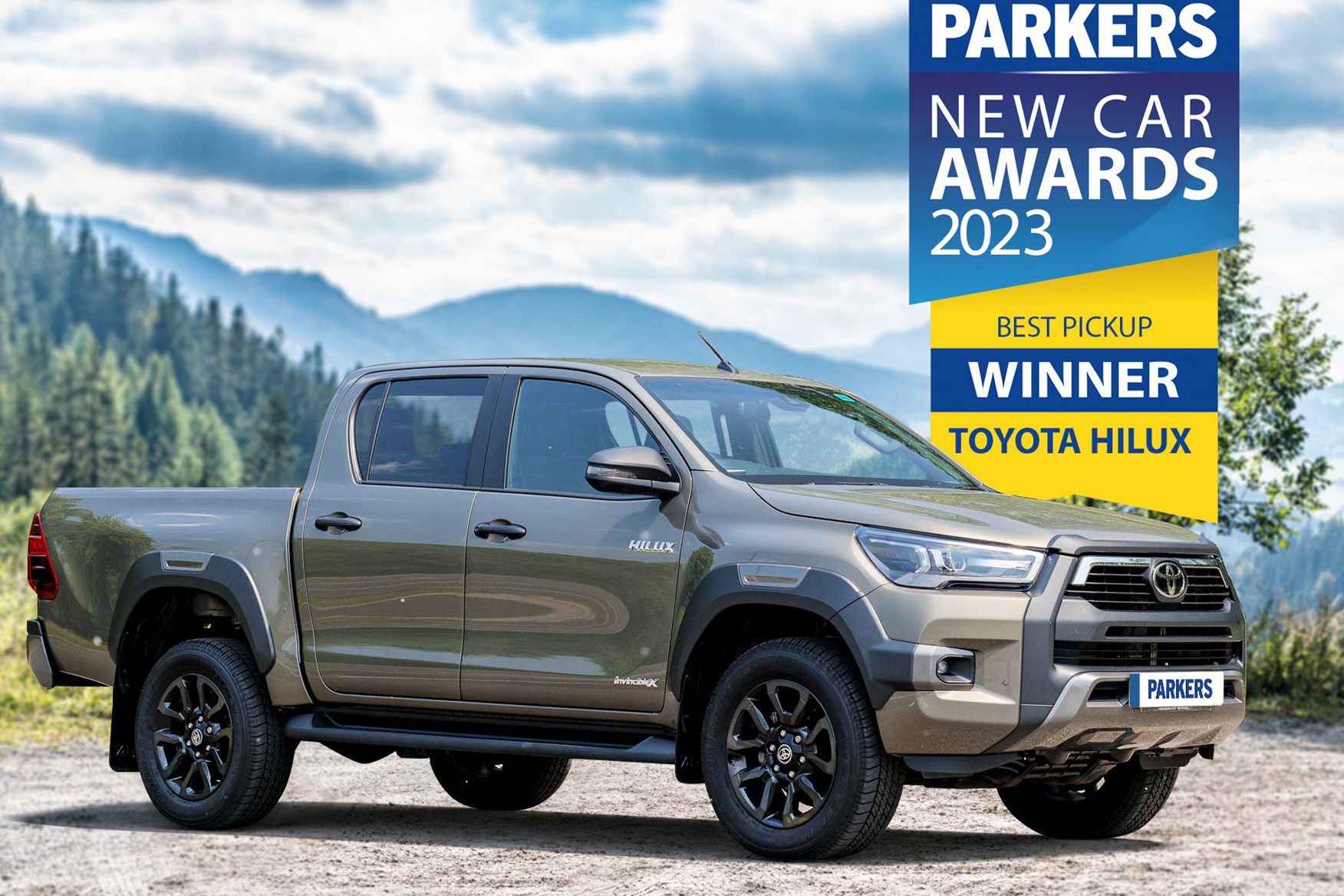
2020 Toyota Hilux facelift
Capitalising on the demise of the big V6-engined Volkswagen Amarok and Mercedes-Benz X-Class, and Ford's decision to discontinue the 3.2-litre Ranger, the introduction of the 2.8-litre Hilux is proving to be a big draw to Toyota showrooms in 2021.
With 204hp and 500Nm of torque, this new engine instantly resolves any complaints about the 2.4-litre model's lacklustre performance, and has clearly been an answer to the prayers of many Hilux customers.
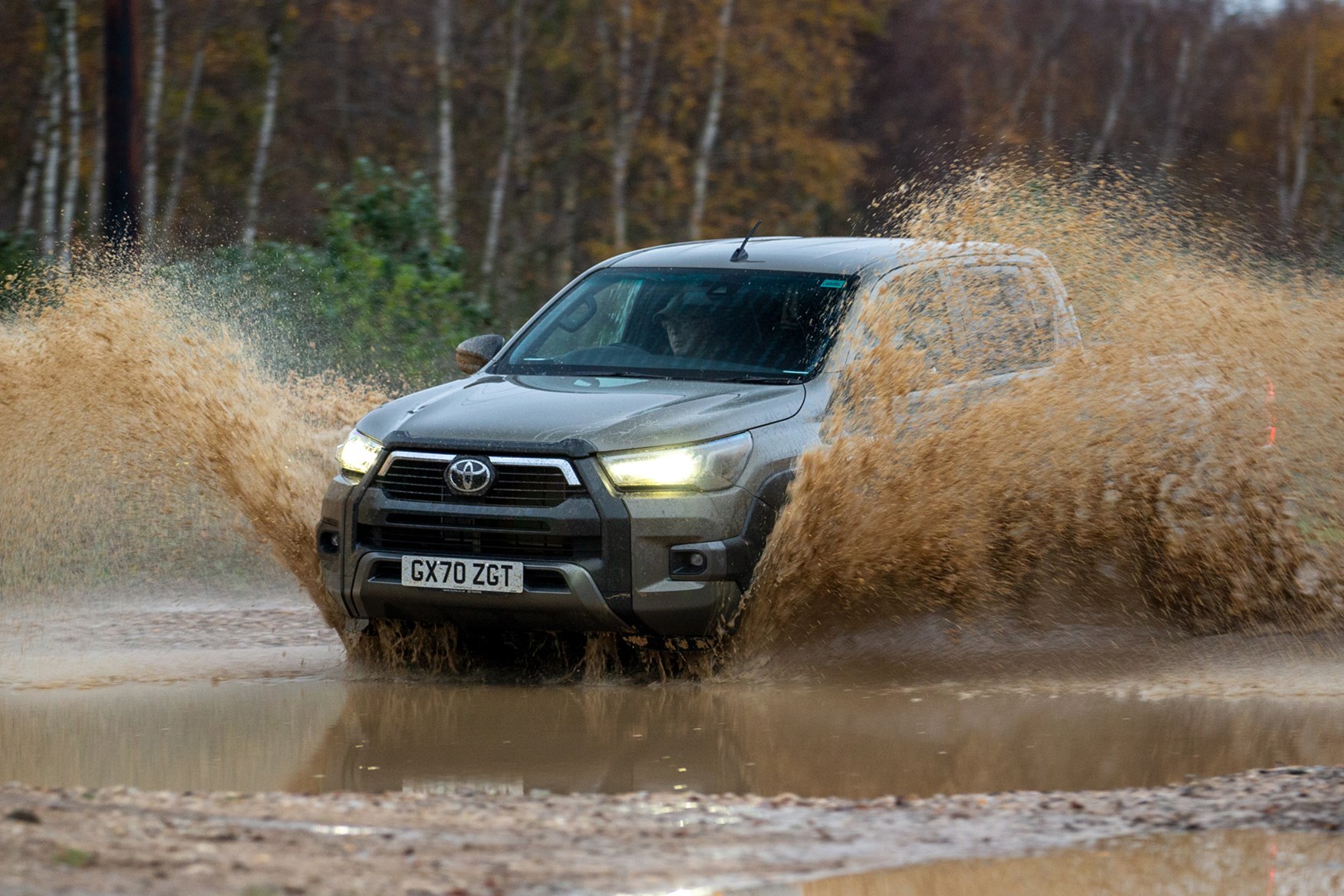
On sale from November 2020, this engine is just one part of a major Hilux facelift that also saw improvements to the suspension and the overall look of the vehicle. The changes make the Hilux better to drive on- and off-road.
What's good about the Toyota Hilux?
The Hilux offers better-than-average comfort for a pickup, something that has been achieved despite the continued use of leaf-spring rear suspension, which is supposed to be less compliant than the more sophisticated coil springs used by some rival models.
The interior is neat and modern, with a prominent tablet-style panel in the centre for the infotainment, which takes the form of a touchscreen on all but the most basic trim level.
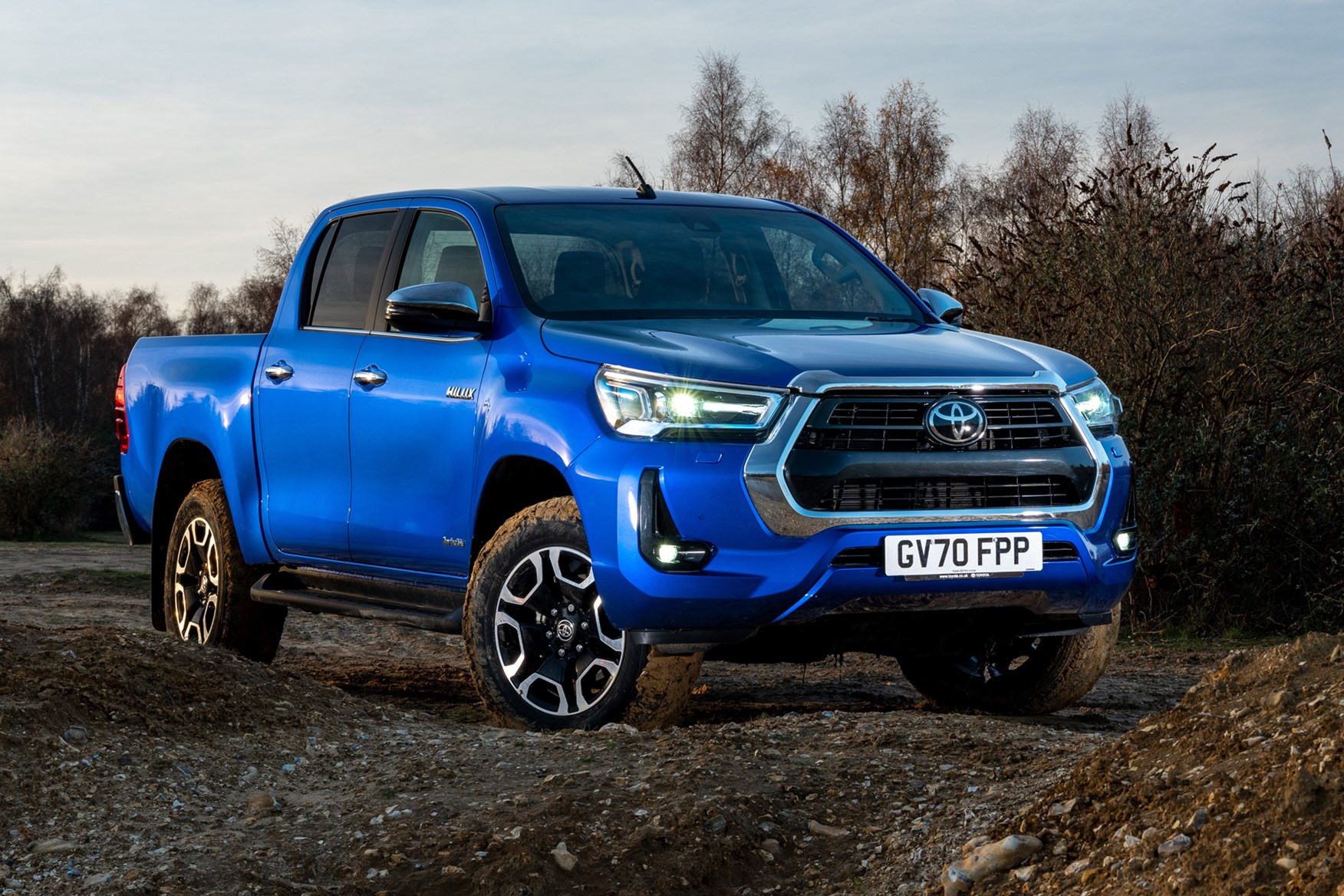
But the main reason for buying a Hiilux has got to be that legendary toughness and reliability, something that's typically evidenced by owner satisfaction surveys.
What's bad about the Toyota Hilux?
Bad is a strong word, but until the 2.8-litre engine arrived, this Hilux was decidedly disappointing under the bonnet.
Prior to late 2020, UK and western European buyers were limited to just one engine choice - a 2.4-litre four-cylinder turbodiesel with 150hp and 400Nm. This remains the only choice for buyers who don't opt for the top spec Hilux Invincible and Invincible X models.
The 2.4 doesn't deliver a lot of power. And while this Hilux can tow up to 3,500kg (3.5 tonnes), it is also undeniably slow, taking up 13.2 seconds to go 0-62mph.
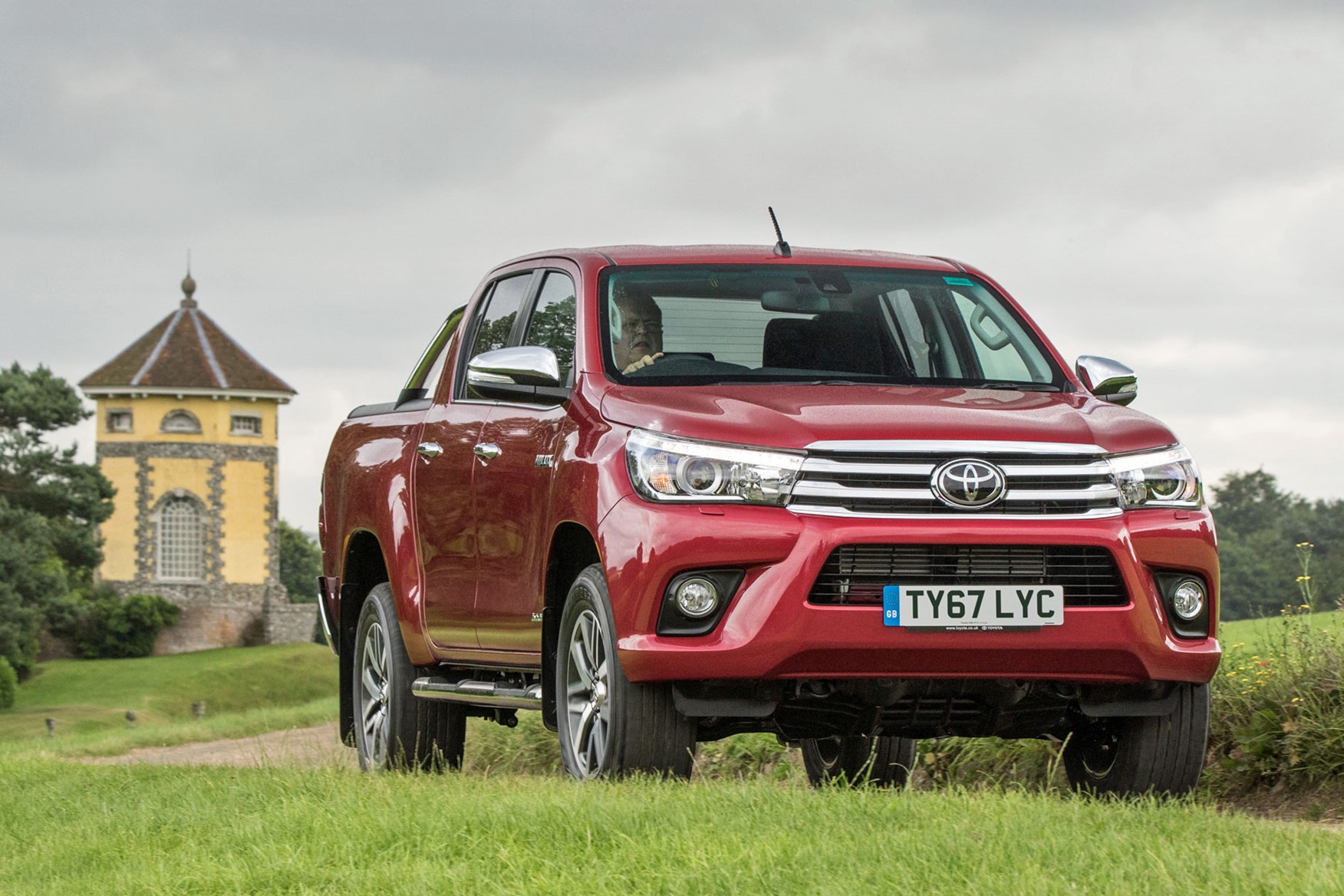
In less serious concerns, opinions tend to be split over the look of the original front end (above), which some operators feel is rather 'beaky'. The range-topping Invincible X model redressed this issue when it was launched in 2018 by coming with an alternative front bumper.
Now every model gets an improved look, thanks to the mid-life facelift - the Invincible X once again taking things further with a bespoke appearance that includes a number of unique exterior add-ons.
Toyota Hilux body variants and trim levels
The Hilux is one of only a few pickups on sale in the UK that offers Single Cab, Extra Cab and Double Cab body styles:
- Single Cab = two doors and two seats
- Extra Cab = full-size front doors, half-width rear doors, occasional-use rear seats
- Double Cab = full-size doors front and rear, five proper seats (though rear middle won't be comfortable for adult humans for long)
Most lifestyle buyers will be best served by the Double Cab, but the smaller the cab, the larger the load area - which may be more important to operators after a working truck.
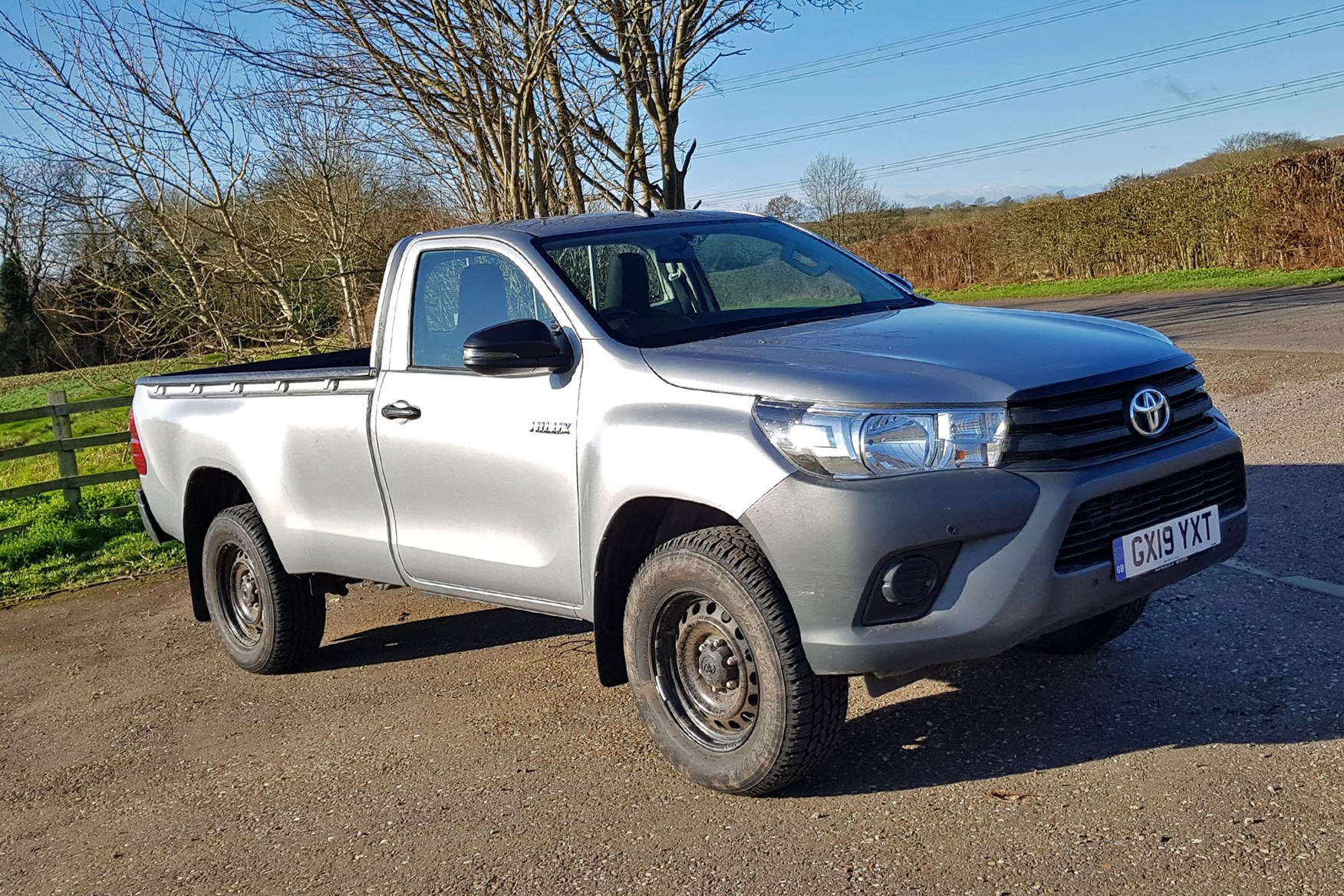
The entry-level Active trim is the only one offered in all three body styles, and this still includes important creature comforts such as air-conditioning, seven airbags, heated electric mirrors and rear differential lock as standard. The bumpers are unpainted black plastic on this model, making it easy to identify.
The remaining three trim levels - Icon, Invincible and Invincible X - are all Double Cab only, feature a touchscreen infotainment system, DAB digital radio and a reversing camera, among many other additional items.
Every trim level gained additional items of equipment during the mid-life facelift in 2020.
Toyota Hilux AT35
When Toyota introduced the Hilux Invincible X to the UK at the 2018 CV Show it almost stole its own thunder - by showing an AT35 version of the Hilux at the same time.
The AT35 is an extreme off-road variant, with hardware and body modification by Icelandic legends, Arctic Trucks. And as of the CV Show 2018, you can order one direct from your local Toyota Hilux dealer.
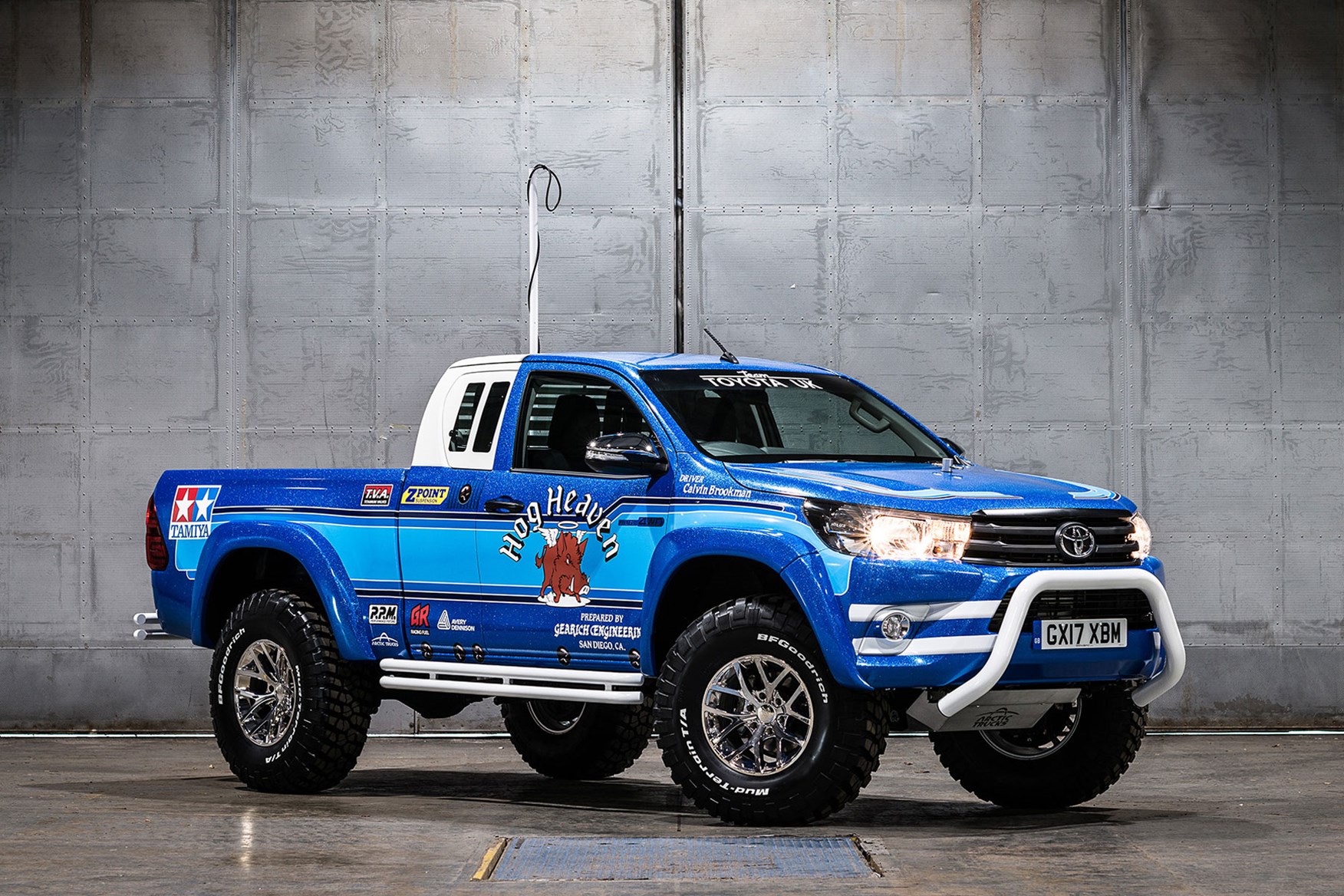
Want to know what the Hilux AT35 is like to drive? Then check out our review of the Hilux Bruiser show car, which is fitted with all the AT35 kit.
Toyota Hilux rivals
The Ford Ranger is the UK's bestselling pickup, offering a wide range of versions and lots of adaptability for different uses, with keen pricing. The outgoing models were strong enough but 2023 brings an all-new model. That truck also forms the basis of the new VW Amarok.
Toyota's traditional pickup rivals, however, are the Nissan Navara and the Mitsubishi L200 - which also offer five-year warranties. Good news for Toyota, then, that both of these have both been discontinued.
This leaves the Isuzu D-Max and the SsangYong Musso as the only other remaining rivals to the Hilux. The latest D-Max has class-leading safety levels and worth considering especially if you primarily need a working vehicle. The Musso has enormous payload and towing capability. Both have lengthy warranties, too.
Given the pricing, the Hilux buyer would also have done well to consider the Mercedes-Benz X-Class but this was discontinued in 2020.
Toyota Hilux verdict
If reliability is your main pickup concern, the Toyota Hilux is an excellent starting point. That it's also reasonably comfortable, very capable off-road and able to tow up to 3,500kg means it's a versatile all-rounder as well.
The 2.4-litre engine is a severe limitation, as it's the least powerful offered in any UK pickup. Fortunately, the arrival of the 2.8-litre motor has solved this problem extremely convincingly - adding all the performance most pickup buyers will ever need while offering almost identical fuel economy.
All of which means it's now one of the very best pickups you can buy in the UK.
Skip to our full verdict on...
- Reasonably quiet, with good ride despite leaf springs
- 150hp engine is not very fast; 204hp engine certainly is
- Extremely accomplished off-road
Compared with the previous model, this eighth-generation Toyota Hilux has significantly improved driving characteristics both on- and off-road. This makes it one of the most accomplished pickups currently on sale – with a slight proviso about the 2.4-litre engine.
Fortunately, Toyota has understood this problem and thoroughly redressed it with the introduction of the 2.8-litre engine with the 2020 facelift.
How much difference has the new 2.8-litre engine made?
The 2.8D - as the new engine is known - is a large four-cylinder motor that provides 204bhp and up to 500Nm of torque. Compared with the 2.4D engine, which musters 150hp and 400Nm, that's a huge increase.
This makes a big difference to the Hilux driving experience, shaving nearly three seconds from the 0-62mph time, bringing it down to as little as 10.1 seconds.

It's not breathtakingly fast in the manner of the V6 versions of the Amarok and X-Class, which could both do 0-62mph in around seven seconds. But where you would previously have been nervous on shorter slip roads or overtaking slower traffic on country lanes, the 2.8D Hilux now has performance to spare. So much so you start to wonder if it couldn't do with slightly better brakes...
The introduction of the 2.8D has also cemented the six-speed automatic as the Hilux gearbox as choice. The two make an excellent pairing, and we rarely found ourselves wishing for the extra ratios provided by some rival automatic transmissions (even if these would perhaps boost the fuel economy).
What's more, versions of the Hilux 2.8D fitted with the six-speed manual gearbox are limited to 420Nm of torque - underlining that the 2.8D auto is really the uliimate Hilux now.
Is the Toyota Hilux comfortable?
Comfort is another area that's been further improved with the mid-life revisions that come along with the 2.8-litre engine.
Despite sticking with leaf-spring rear suspension – which is typically more tough than it is tuneable and refined – Toyota has managed to deliver a vehicle that does a better than average job of cushioning the blows from bumpy terrain.
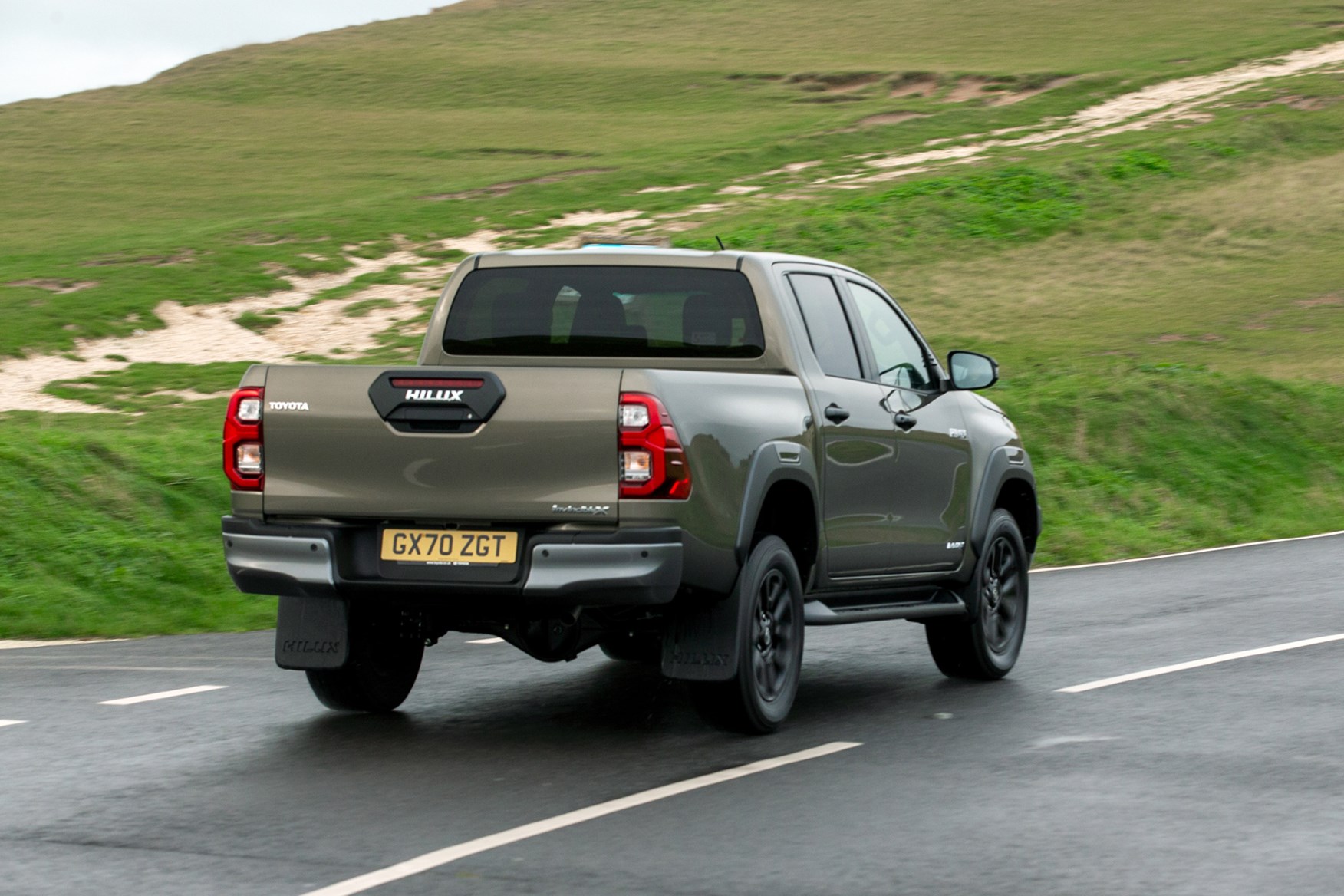
For the facelift, Toyota has changed the front and rear shock absorbers as well as further re-worked the rear leaf springs and modified some of the bushes. But the big difference this time around is that it did this work to optimise the suspension while the load bed was empty.
Previously, Toyota has always tuned the Hilux's suspension when it was fully loaded - but the rise of lifestyle buyers and the realilty that most owners rarely drive with the truck loaded to the max has seen the firm change this approach to make the Hilux more comfortable more of the time.
It can still feel quite firm around town at low speeds. But things get noticeably better as you go faster, with only very sharp intrusion or sudden potholes really jarring the cabin.
There is still a bit of judder occasionally, but the Hilux can now compete with the best rivals in this area now - though the latest Ford Ranger still has a slight edge, and the 2021-onwards Isuzu D-Max has made massive improvements in this area as well.
What’s the Toyota Hilux like to drive?
The Toyota has never been terrible in the turns, but its steering has been decidedly slower than the most agile rivals. Things have got better with the facelift, thanks to the introduction of a 'variable flow control' power-steering pump, which manages to make the front of the Hilux feel more reassuring both on and off the road.
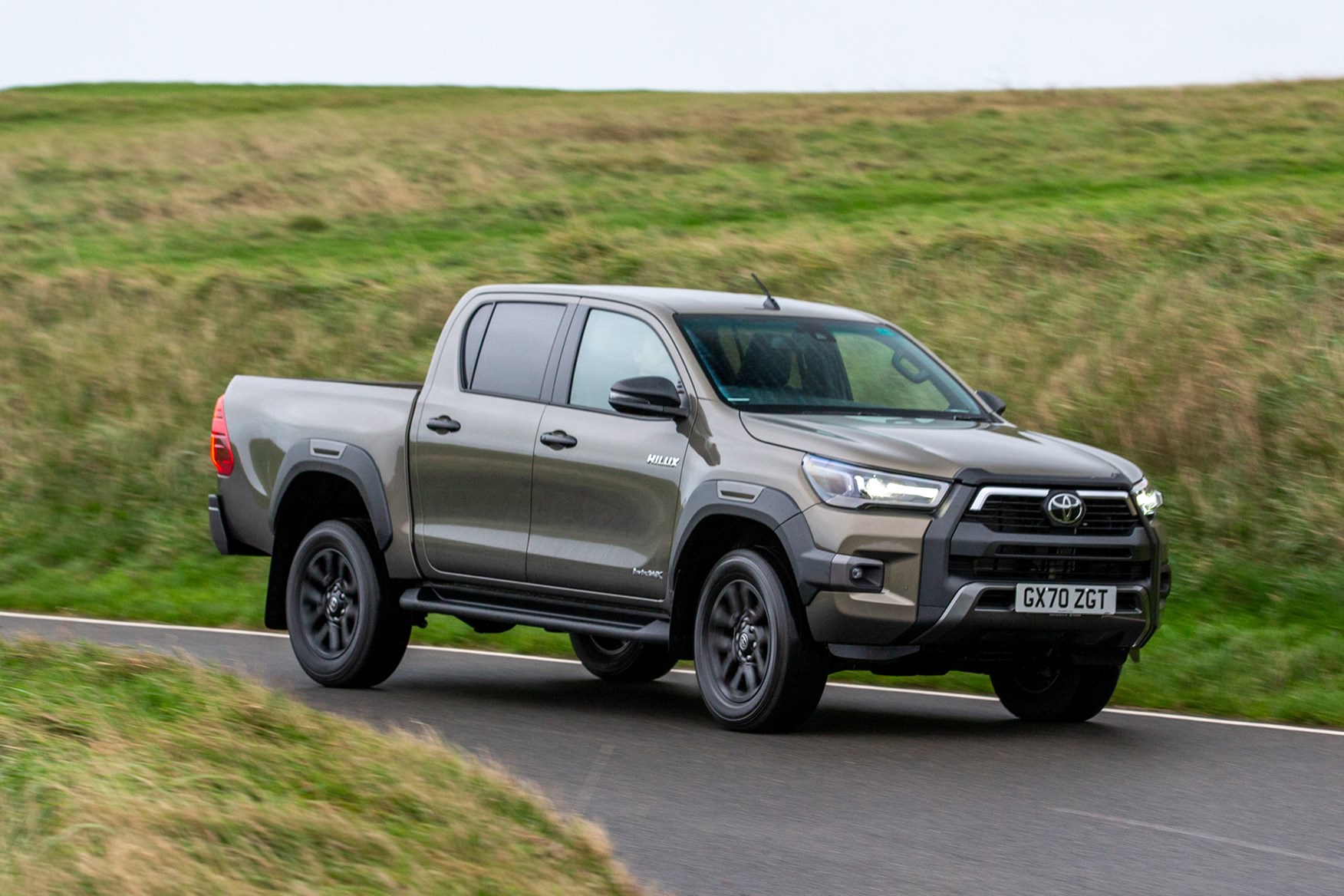
Body roll is well controlled, too, though you're unlikely to be encouraged to go too quickly in one of these, which probably helps.
If you do want to press on, the facelift has also brought in an automatic limited slip differential - standard on all but the entry-level Icon grade - which helps the rear wheels find traction on slippery surfaces. This is actually more use on the road than off it.
The panoramic view monitor, which is now a standard fit on top trim, really does help squeezing the hefty Hilux into a tight spot that bit easier, as it'll let you have a bird's eye view of the car to see if you have left any of it hanging over the extremities of a space. It's handy off road too, though. Flick it on while you're traversing some particularly tough terrain and it'll help highlight any rocks or tree stumps or similar that might be hiding in a blind spot. It could prevent a passenger flinging a door into something that does serious damage for example.
Excellent refinement for a pickup truck
Pickups are not typically very relaxing vehicles to drive. While their use of a separate ladder-frame chassis below the body is good for strength, it can lead to all kinds of squeaks and rattles.
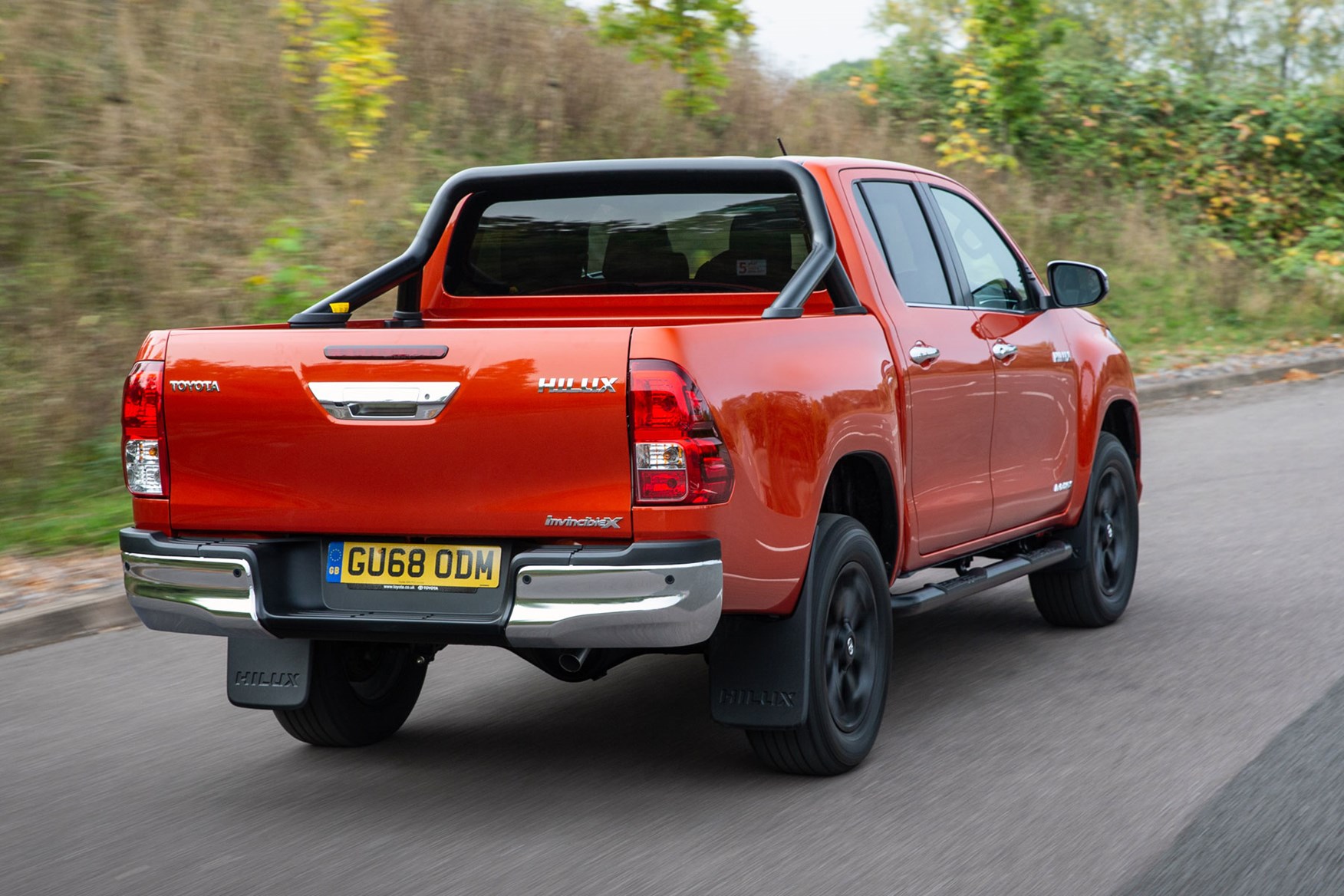
Toyota’s engineers have worked to combat this in the Hilux by installing a so-called ‘dash silencer’, alongside additional sound-proofing in the engine bay to minimise noise and vibrations. This largely seems to work very well, and there have been further refinements as part of the mid-life makeover.
While you’ll certainly hear the diesel engines when starting from cold or under hard acceleration, you very rarely feel any tremors from inside the cabin – and engine noise at a constant cruise is limited to a quiet hush.
Immense off-road capability
While the revised looks of the facelift model see the approach angle reduced from 31 degrees to 29 degrees, the Hilux is otherwise even better off road than it was before.
It's almost impossible to stress how impressive this thing is. For a pickup, the 2020-onwards version has truly remarkable rear axle articulation to help it deal with off-set bumps, while a 700mm wading depth and exceptionally competent electronics mean it will take you places you didn't think a standard road vehicle could go, even without engaging the locking differentials that are available.
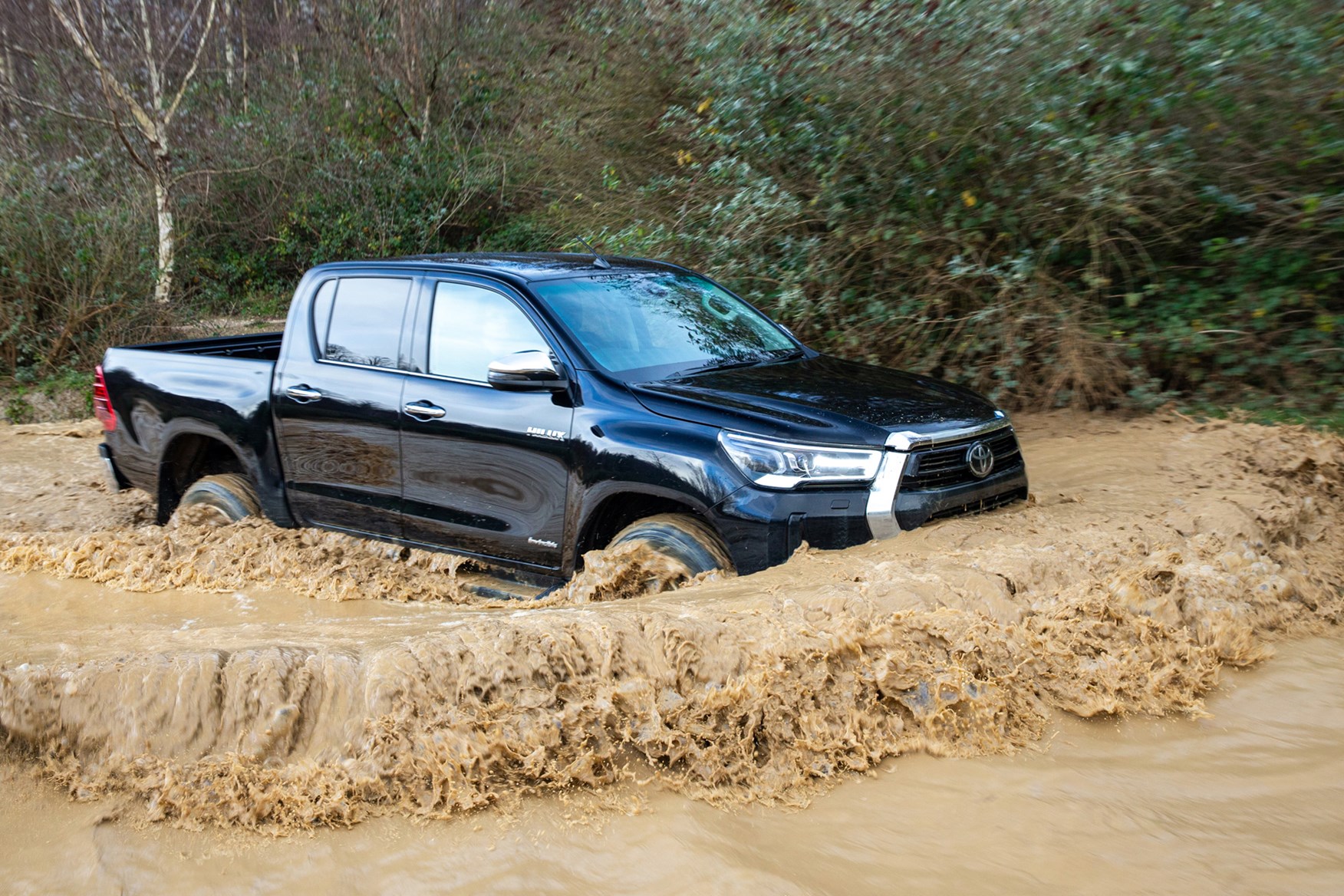
We've tested every element of this capability, and on the standard road tyres the Hilux dispatched a challenging extended off-road run without breaking sweat. Certainly there was no sign of it losing its footing anywhere - not even on slippery downhill sections, where the hill descent control acts quickly and decisively with little fuss beyond an efficient, robotic-sounding electronic buzz.
The extra power and torque from the 2.8D engine are as welcome off the road as they are on the road, but what's more, Toyota has lowered the idle speed and changed the accelerator response in the low-range L4 off-road mode, in order to increase the facelifted version's level of control.
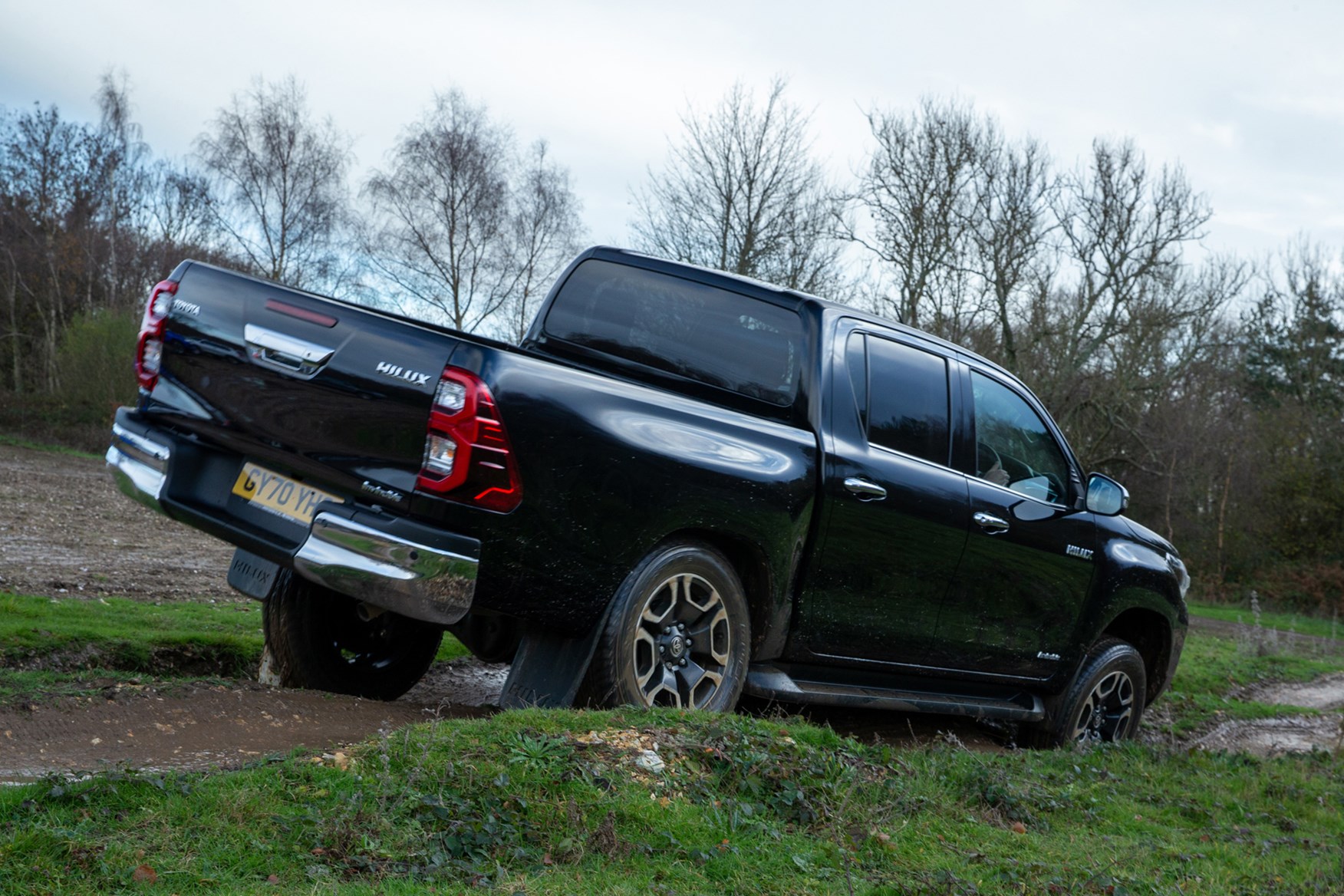
L4 is the most extreme of the 4x4 settings, which also include H2 and H4 - H2 being the usual rear-wheel drive mode you use on the road, H4 the equivalent four-wheel drive setting for less challenging off-road work.
Each of these is accessed via a simple rotary controller, and an electronically controlled centre differential.
To complete the off-road stats, Single Cab models have a 25 degree departure angle, while the Extra and Double Cab are rated at 26 degrees; Toyota doesn't quote a breakover angle, but minimum ground clearance post-facelift is 277mm for the Single Cab, 289mm for the Extra Cab and 310mm for the Double Cab.
- Modern, car-like cab interior that's well made
- Sensible control layout, tablet-style touchscreen
- Not a massive amount of in-cab storage
The Hilux has a strikingly modern interior, something you may not necessarily expect of a pickup truck so traditionally associated with hard-working reliability and practicality.
For all its sharp design, however, the cabin still places ease of use front and centre. The instruments are clear, the buttons are large and the control layout is generally sensible.
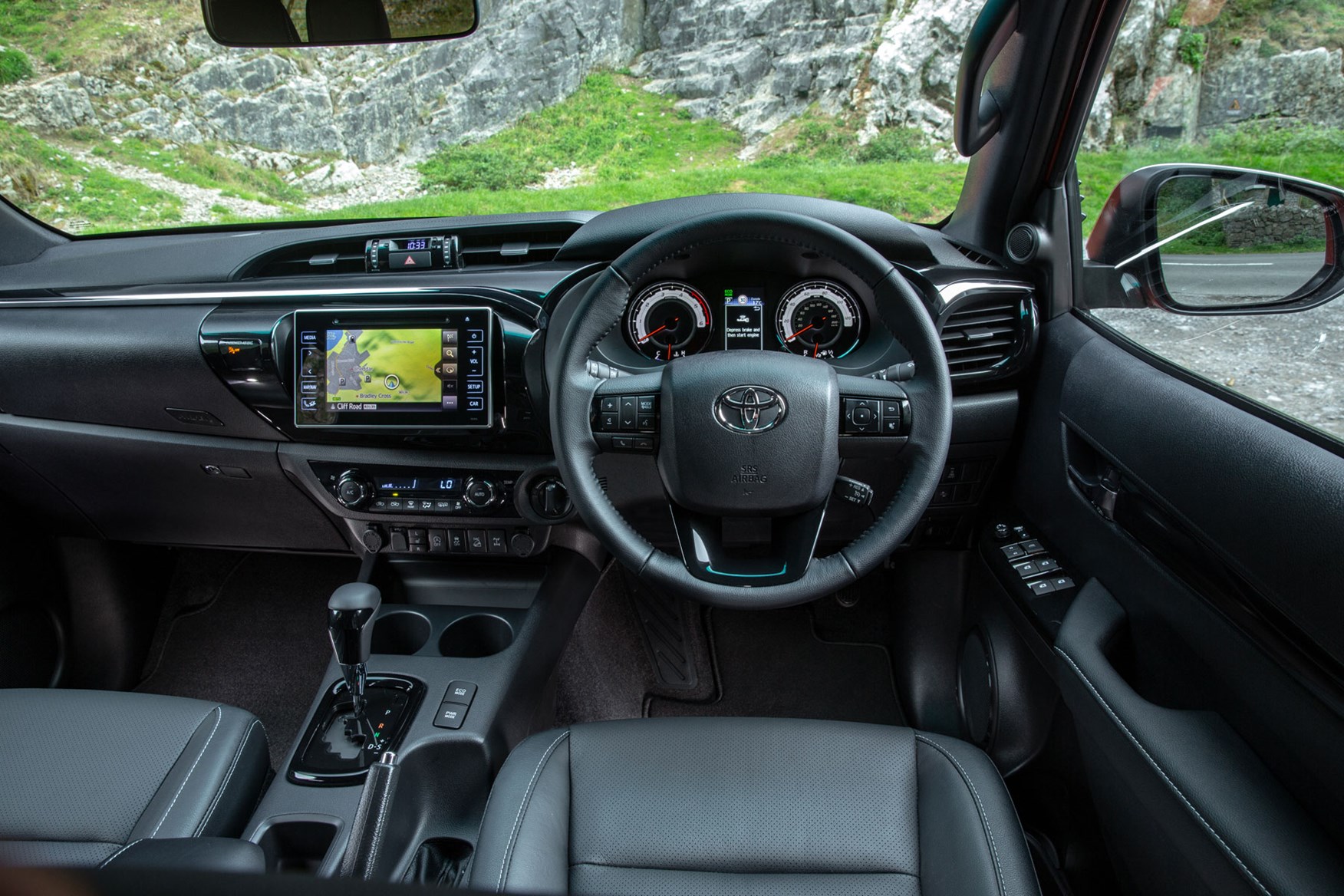
All models come with air-conditioning, and you certainly won’t have any difficulty adjusting the temperature. Similarly, switching the four-wheel drive system between modes is easily done.
All versions bar the entry-level Active models get a central touchscreen infotainment system, and on the original 2016-onwards models (above) this is reasonably straightforward 7.0-inch model.
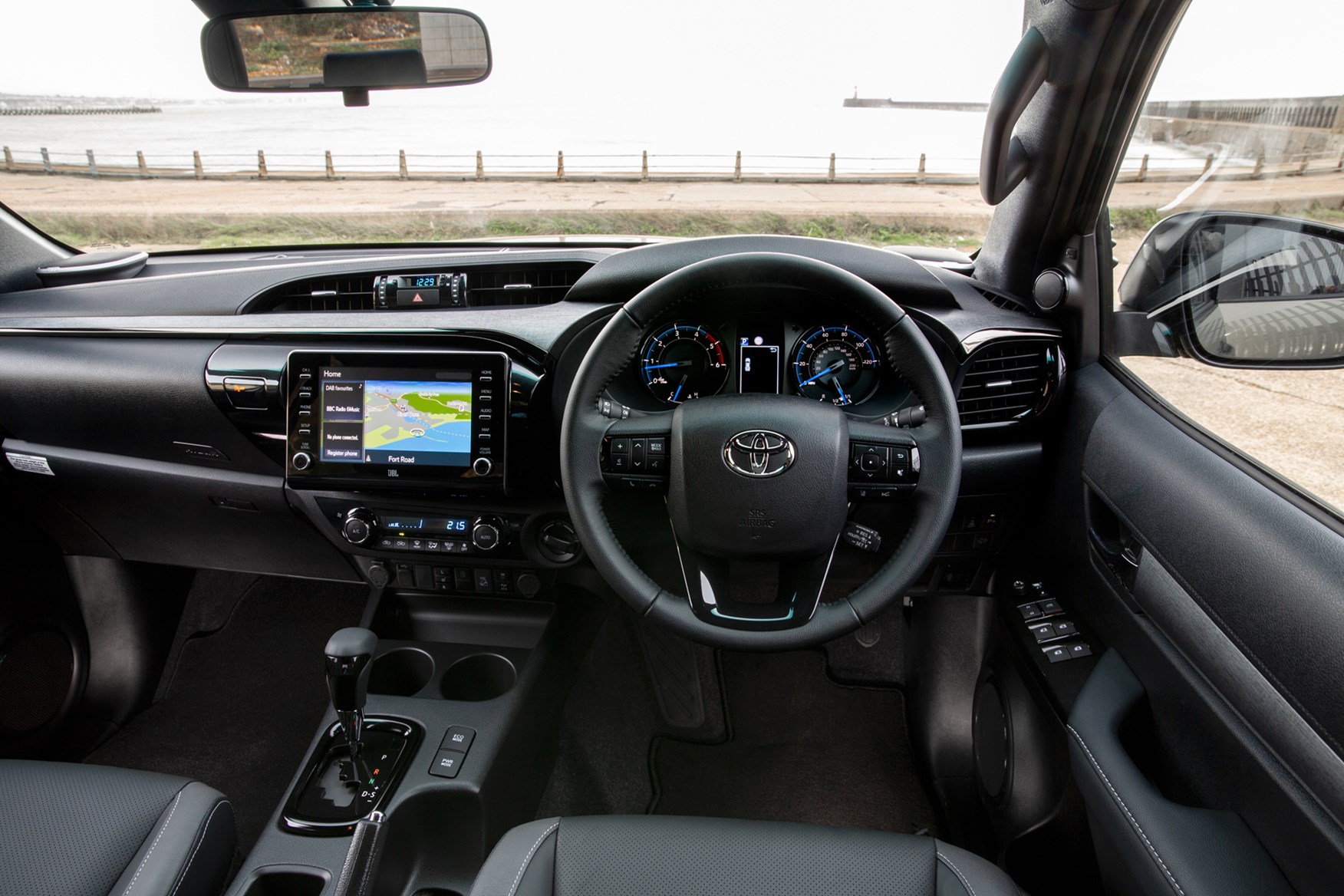
For the facelift, the infotainment has been upgraded to a much newer 8.0-inch Toyota Touch 2 system, which brings significant improvements, however, especially to the sat-nav.
It also has an increased number of physical buttons, to make it easier to use when driving, particularly over bumpy ground. We commend this approach, even if the software still lags someway behind in user-friendliness compared with rivals.
The 2022 update brings a few small updates to the kit list, with a 360-degree camera, or Panoramic View Monitor as Toyota calls it, added as standard on the Invincible X. An auto-dimming rear view mirror is also added to the top two trims, as is dual-zone air con.
Toyota Hilux cab interior build quality and visibility
The Hilux feels well made, and if the materials aren’t necessarily the most luxurious they do at least give the impression that they are built to last.
We’re not quite sure what to make of the fake stitching on the top of the dashboard (it’s moulded into the plastic for some reason), but good all-round visibility makes the Hilux easy to handle in most situations.
Toyota Hilux passenger space and in-cab storage
The front of the cab is spacious, and the seats are comfortable. The steering wheel tilts and telescopes for reach and rake adjustment, too, and although the reach adjustment could be greater, at least it has some - unlike some rivals we could mention. Still, finding your ideal driving position might involve a bit of compromise of the sort that you now very rarely have to make in a modern car.
Taller passengers won’t be keen to get in the back of the even the Double Cab variants, sadly, as knee room is a touch limited.

In-cab storage space is also slightly lacking, even if you do get two gloveboxes. Perhaps most buyers are happy to compromise in this area in exchange for the car-like dashboard design.
- Expensive to buy but tough and long-lasting
- Up to 10 years of warranty coverage
- Plenty of standard equipment on all versions
The Hilux is one of the more expensive pickups on the market - but that isn't to say it's bad value. You get a lot of standard equipment, and the upgrade to the 2.8-litre engine is surprisingly affordable.
It also holds its value extremely well, which means that monthly finance costs can be highly competitive. And while fuel economy isn't the best in the pickup truck sector, the Hilux should prove very reliable, saving you money that might be lost by unscheduled downtime and unexpected repairs.
>> Find a Toyota Hilux for sale near you via Parkers
Toyota Hilux mpg
According to the latest WLTP figures, the facelifted Toyota Hilux range should return between 27.1mpg and 33.2mpg, depending on model. There is little difference on paper between the 2.4D and the 2.8D. In theory the bigger engine should prove the more efficient, but that will probably depend on how you drive it.
All models come with stop-start technology now, while opting for the automatic transmission will cost you around 3mpg. The 2022 update means that all the Hilux's engines are RDE2 compliant. This will mean little in terms of how the vehicle drives, but it does mean that the Hilux should be able to get within 1.5 times of the official fuel economy, so what you what you see shouldn't be too far off what you get on that front.
Toyota Hilux service intervals and warranty info
Up until 1 June 2021, this Hilux came with a five-year warranty that covers up to 100,000 miles of driving.
At this point the firm switched to the new Toyota Relax warranty scheme, which includes three years / 60,000 miles of standard coverage that extends to up to 10 years / 100,000 miles if you continue to get your Hilux serviced by Toyota.
Toyota Relax means you can even get warranty coverage on a used vehicle, as long as it's no older than 10 years or 100,000 miles - full details are available on our Toyota Relax warranty explainer page.
Service intervals are every 10,000 miles or once a year, whichever comes sooner.
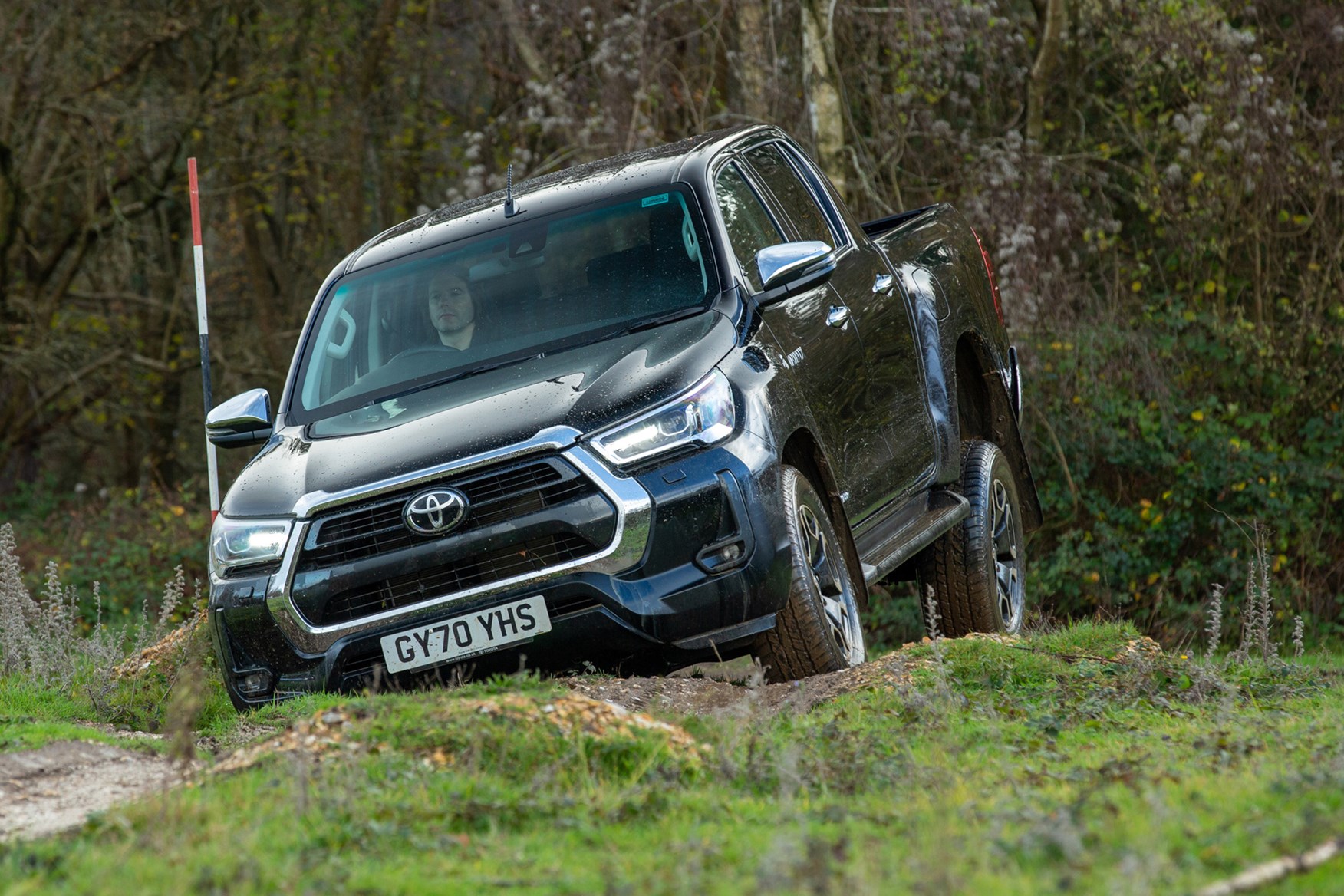
Toyota offers fixed-price servicing - so you should know exactly what you’ll have to pay ahead of time - as well as various servicing plans to help spread the cost, tailored for retail and business customers.
Better still, the Toyota Professional dealer network was launched in February 2020, a service that is (at the time of writing) available in 123 of Toyota's 168 UK dealer locations.
This not only helps fulfill the warranty and roadside assistance, it also promises a prioritised level of service for commercial vehicle customers, as Toyota's recognition that these customers depend on their vehicles to do business.
As such, if you can't get an appointment within seven days of asking, you'll get the work done half price.
Toyota Hilux standard equipment
These are the standard equipment highlights of each Hilux trim level as of the introduction of the facelifted model in December 2020; for details of safety equipment see the Safety and Security section below.
Toyota Hilux Active standard equipment highlights:
- 17-inch steel wheels
- Automatic headlights
- Heated, power-adjustable door mirrors
- Reach and rake steering wheel adjustment
- Steering wheel with telephone and infotainment controls
- 4.2-inch TFT information screen in instrument cluster
- Manual air-conditioning
- Front cool box
- Bluetooth
- Rear differential lock
- Adaptive cruise control
Toyota Hilux Icon standard equipment highlights (in addition to Active):
- 17-inch alloy wheels
- Power-folding door mirrors
- Headlight cleaners
- LED front fog lights
- Side steps
- Silver interior trim highlights
- Leather steering wheel, gear lever and handbrake trim
- Toyota Touch 2 infotainment system with 8.0-inch display screen
- Reversing camera
- DAB digital radio
- Apple CarPlay and Android Auto
- Active limited slip differential
Toyota Hilux Invincible standard equipment highlights (in addition to Icon):
- 18-inch alloy wheels (new design)
- LED headlights
- Black side bars with integrated steps
- Keyless entry and start
- Automatic air-conditioning
- Front and rear parking sensors
- Heated front seats
- Windscreen wiper de-icer
Toyota Hilux Invincible X standard equipment highlights (in addition to Invincible):
- Unique bodywork, including front bumper with skid plate, front grille, wheelarch over-fenders in black plastic, individual door handles, distinctive tailgate treatment
- Perforated leather seat with power-adjustment for the driver
- Toyota Touch 2 with Go infotainment system including sat-nav and voice control capability
- Ambient lighting
- Black and dark chrome trimmings
- Invincible X instrument cluster
- Invincible X key
- Nine-speaker JBL sound system
Toyota Hilux special editions and optional extras
Like most pickup manufacturers, Toyota certainly isn’t shy of a special edition, with the Invincible 50 being a particularly notable example for this generation as it celebrated the model’s 50th anniversary of production in late 2018.
This included a full styling makeover and an Arctic Trucks AT32 conversion for greater off-road capability. You can read a review of it below.
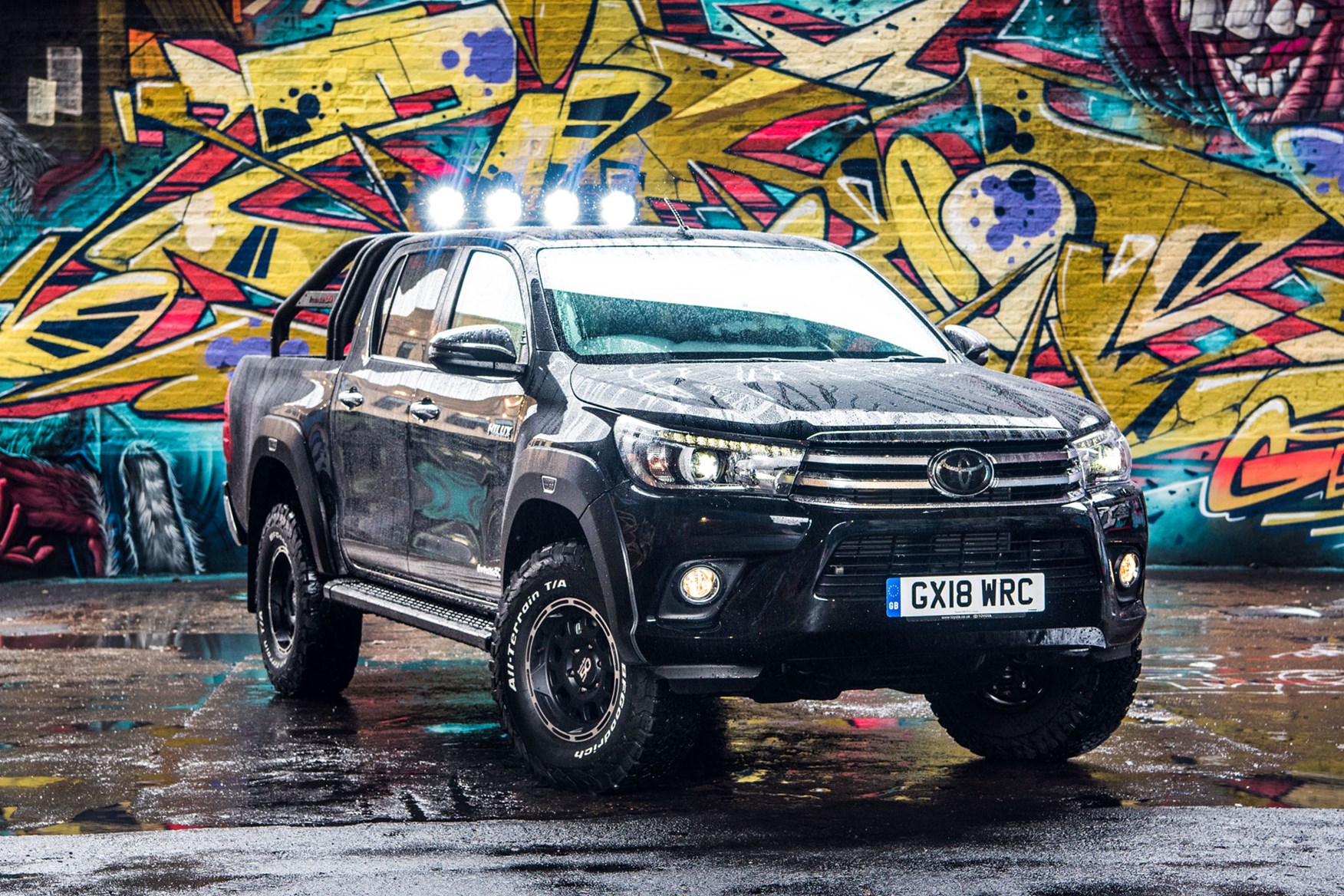
As of mid-2018, this generation of Hilux also became the first available to order from Toyota dealers with a more extreme Arctic Trucks AT35 conversion. See our review of the earlier one-off Hilux Bruiser concept for info on what this is like to drive.
As for optional extras, Toyota offers a large selection of useful enhancements for the Hilux. Depending on trim level this ranges from towing packs to bedliners on the practical side, and styling packs to sport decks in terms of visual fluffing.
The Toyota Hilux is famed for its reliability and regularly features in the FN50 reliability survey as one of the most reliable light commercials on the road. Operators recognise this, and it’s why the Hilux has one of the highest residual value ratings in its class.
Experienced problems with your Hilux? Drop us a line and let us help other readers avoid any pitfalls.
- Seven airbags and ESC as standard on all models
- Autonomous emergency braking standard on high-spec models
- You have to pay extra for an alarm system
As with most modern pickups, the Hilux places an important emphasis on safety.
Not only do all models come with seven airbags and a comprehensive suite of electronic stability control systems as standard, the very structure of this version is said to be 15% better at absorbing crash impact energy than the previous model.
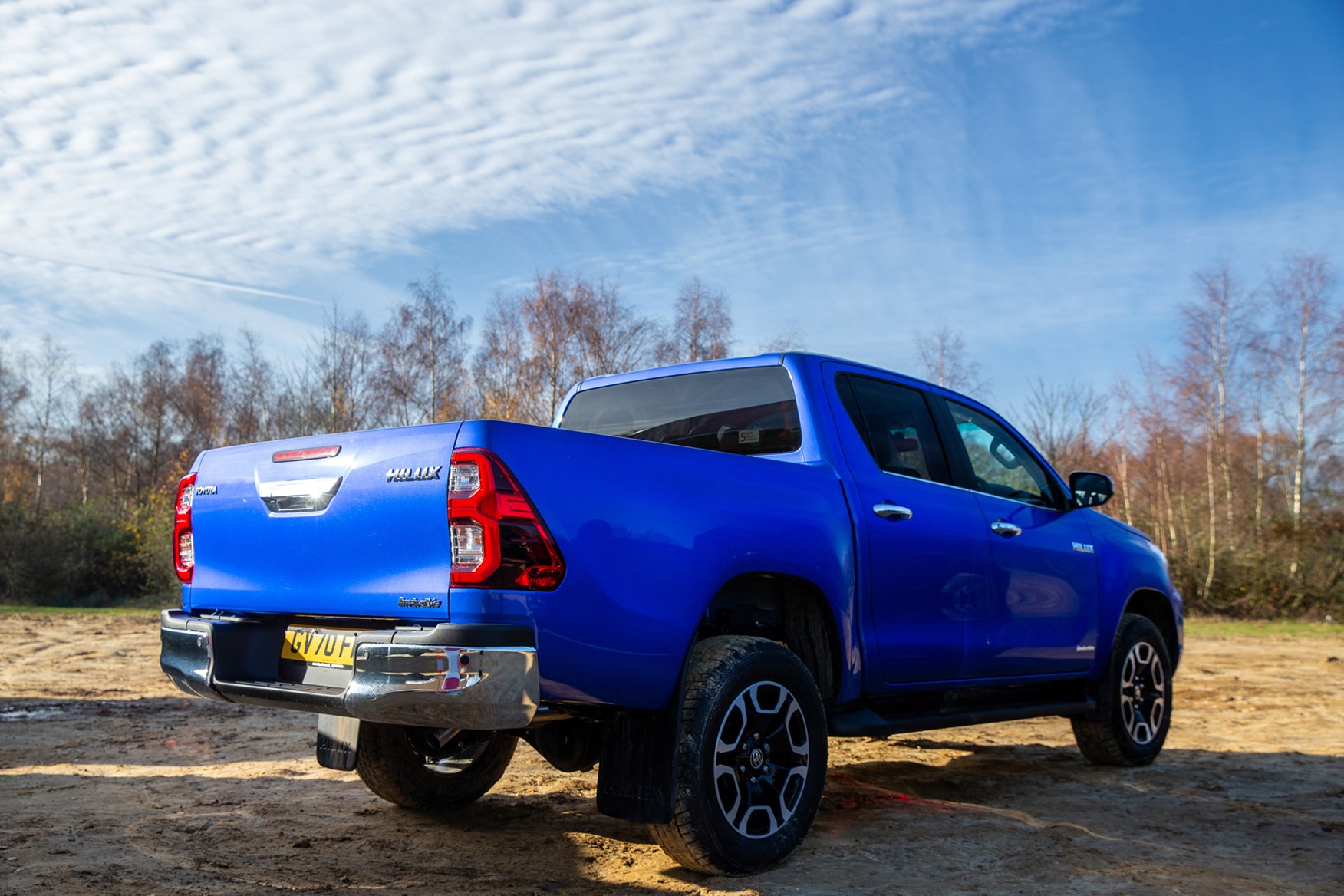
Other standard safety features include seat-belt reminders for the front and rear seats, Isofix mounting points for child seats (Double Cab models only), and front seats with an anti-whiplash design.
Toyota Safety Sense for the Hilux
Since the facelift in 2020, every version of the Hilux is now fitted with the Toyota Safety Sense package as standard.
Toyota Safety Sense is a package that includes autonomous emergency braking in the form of a Pre-Collision System with Pedestrian Detection plus Lane Departure Alert, Road Sign Assist and, since 2019, adaptive cruise control.
Toyota Hilux security
All versions of the Hilux come with a standard-fit immobiliser, but not even the top of the range Invincible X comes with an alarm included in the price.
Which Toyota Hilux is best for me?
Still trying to decide which Toyota Hilux to buy? Then maybe the following individual model reviews will help you make up your mind:
- Toyota Hilux GR Sport review - tested February 2023
- Toyota Hilux Invincible X 2.8D manual review - tested May 2021
- Toyota Hilux Invincible 50 special edition review - tested March 2019
- Toyota Hilux Invincible X automatic review - tested February 2019
- Toyota Hilux Bruiser AT35 review (opens in new page)
And if you're in the market for a new pickup truck make sure you read our comprehensive pickup comparison page, where every model on the market is compared and rated.
Toyota Hilux GR Sport 2.8 review
Tested February 2023 by Tom Webster
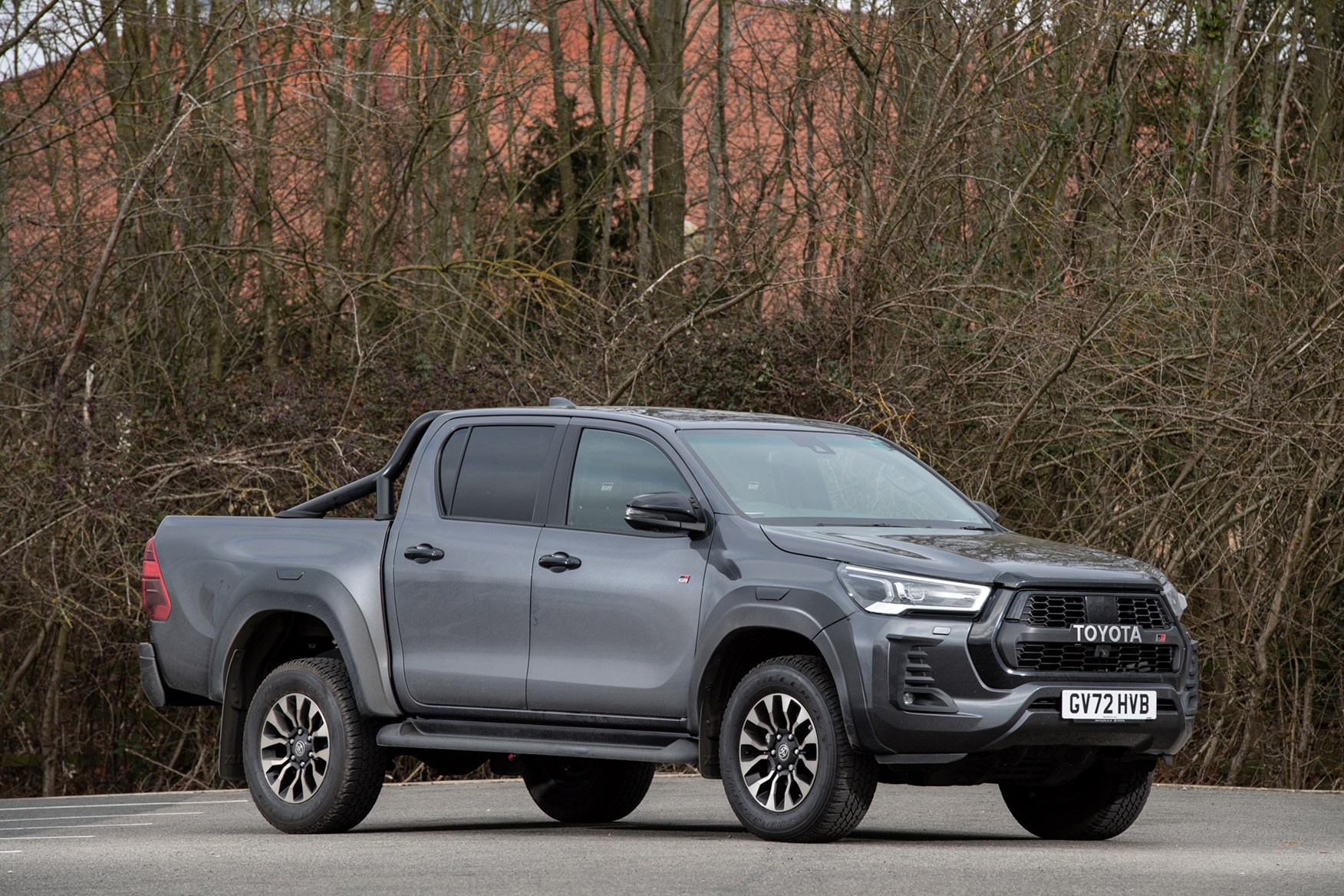
- Visual and specification upgrades for range topper
- Bespoke suspension, sports bar in load bay, sports seats
- Only offered with double cab and 2.8-litre diesel engine
Every pickup truck has to have an all-out lifestyle model these days, and Toyota has embraced the opportunities afforded by its GR Sport performance badge to create this range-topping model.
While this isn’t a full-on performance model, as has happened with the likes of the GR Yaris, it has been given more than just a set of badges and upgraded seats.
What does the Hilux GR Sport get over the rest of the range?
Although there might be more eye-catching upgrades, the GR Sport’s suspension is perhaps the most significant feature. It gets new shock absorbers and new front springs, with the aim being to provide better damping and faster response. This should then give a better reaction when driving over tough ground conditions. The front springs have been stiffened, too, while the shock absorbers are painted red to better stand out.
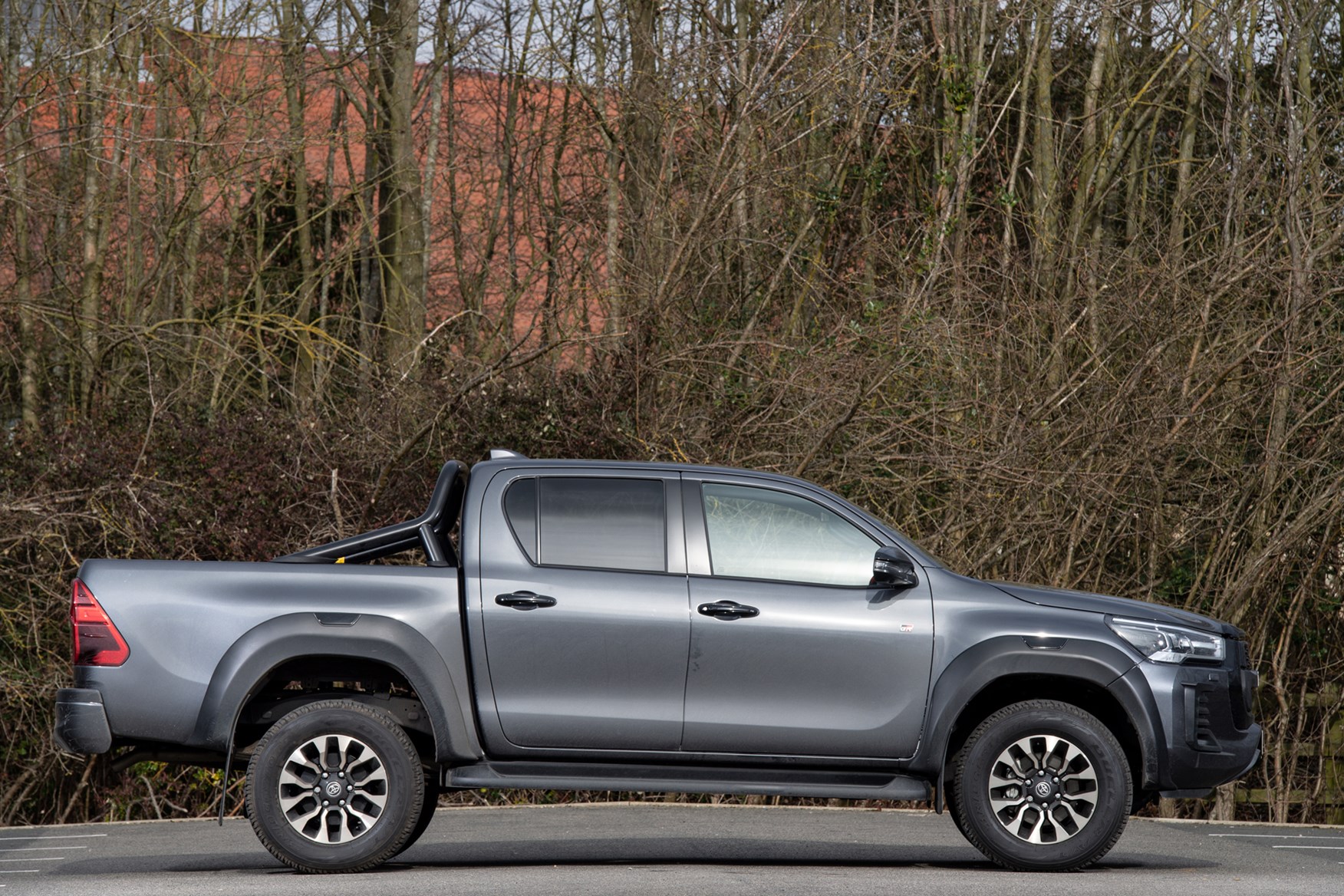
The rest of the additions are cosmetic, with the front grille the one you’ll spot first. It gets a bespoke ‘G-pattern’ design, has larger fog-light surrounds, and has ‘Toyota’ emblazoned in big letters where the badge usually sits. It’s certainly eye-catching, but whether it is to your taste or not is a personal decision. Not everyone in the office loved it when we had one in.
The wheels are 17-inch alloys, which is comparatively small by modern truck standards, and they are clad in all-terrain tyres, suggesting this is geared up for off-road speed more than on-road cruising.
Elsewhere, the loading bay features a chunky sports bar that doesn’t serve any real practical purpose but looks quite striking. You can have this removed free of charge if you want to fit a load-bay cover or hard top though.
Spec is based on the Invincible, but there are a few extra bits of kit, such as the JBL sound system and navigation, heated front and rear seats and an around-view monitor.
LED lights, dual-zone air conditioning, hill descent control and an automatic limited slip differential complete the offering.
What is the Toyota Hilux GR Sport like inside?
Inside you get a pair of front sports seats clad in black leather and synthetic suede and finished with red details and stitching. There are also GR Sport logos aplenty, on the seatbacks, floor mats, starter button and the information display. It’s finished off with a touch of carbon-fibre style detailing and a red line across the width of the cabin. It’s subtle upgrading rather than in-your-face performance imagery.
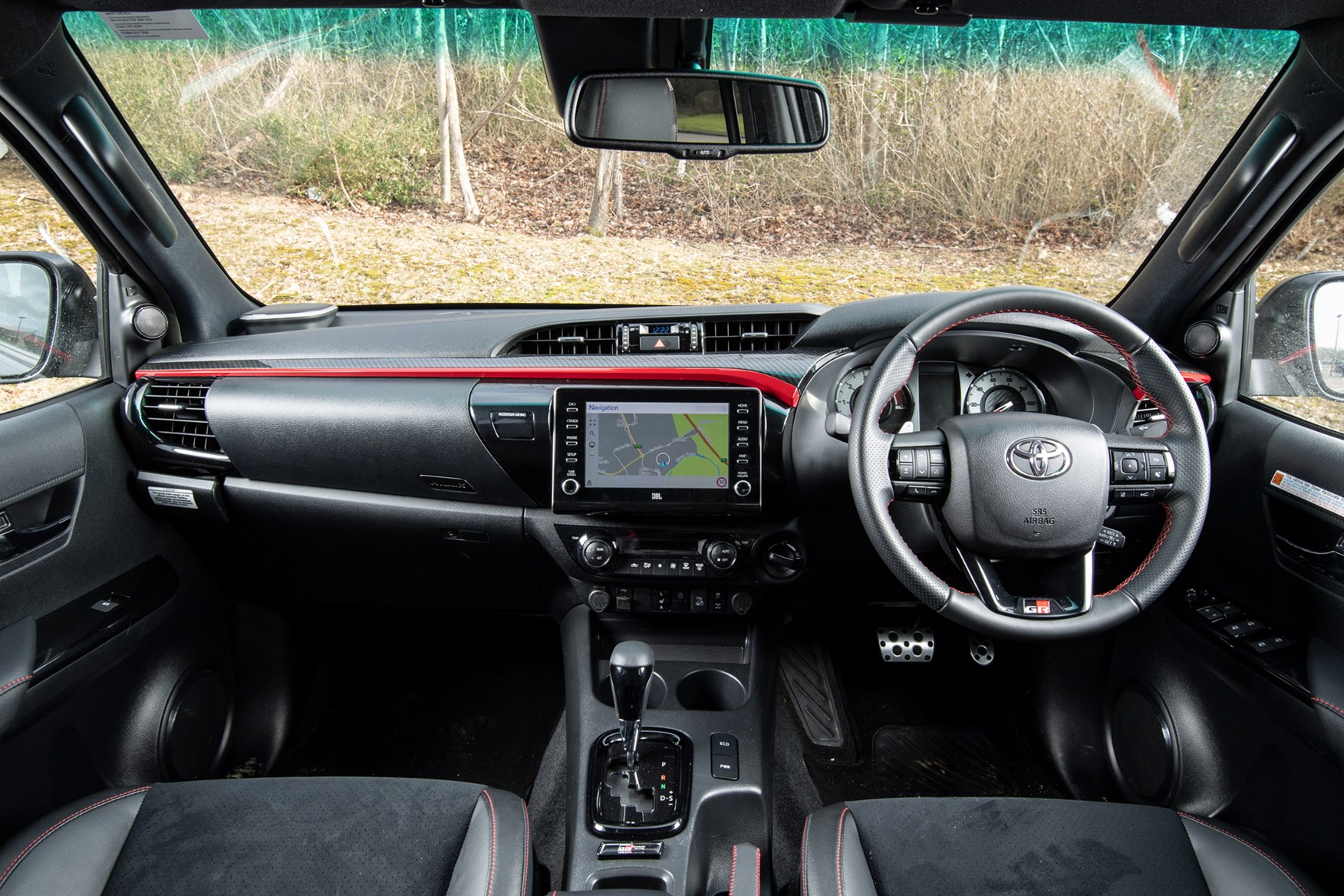
These seats offer a little more side support on the base cushion, which is handy should you need more stability during fast cornering, but the raised edges can be a little uncomfortable when getting in and out. Given the way one gets into a pickup, by climbing up and sliding in, this can take a little negotiating.
The JBL system is not the most modern looking setup these days. The graphics aren’t the sharpest and while you get Apple CarPlay and Android Auto, the connection is restricted to an older USB cable and the small screen means you don’t get it in its full glory as you do on bigger setups.
What is the Toyota Hilux GR sport like to drive?
For the main part, the GR Sport is largely like any other Hilux. The big 2.8-litre diesel engine is the match of any existing pickup rival and provides a decent slug of power and performance without being really quick.
You only get an automatic gearbox, which is rather old school in its approach, with its changes feeling considered rather than fast and snappy. Like the engine this feels appropriate in a vehicle that isn’t really designed to hare about swiftly.
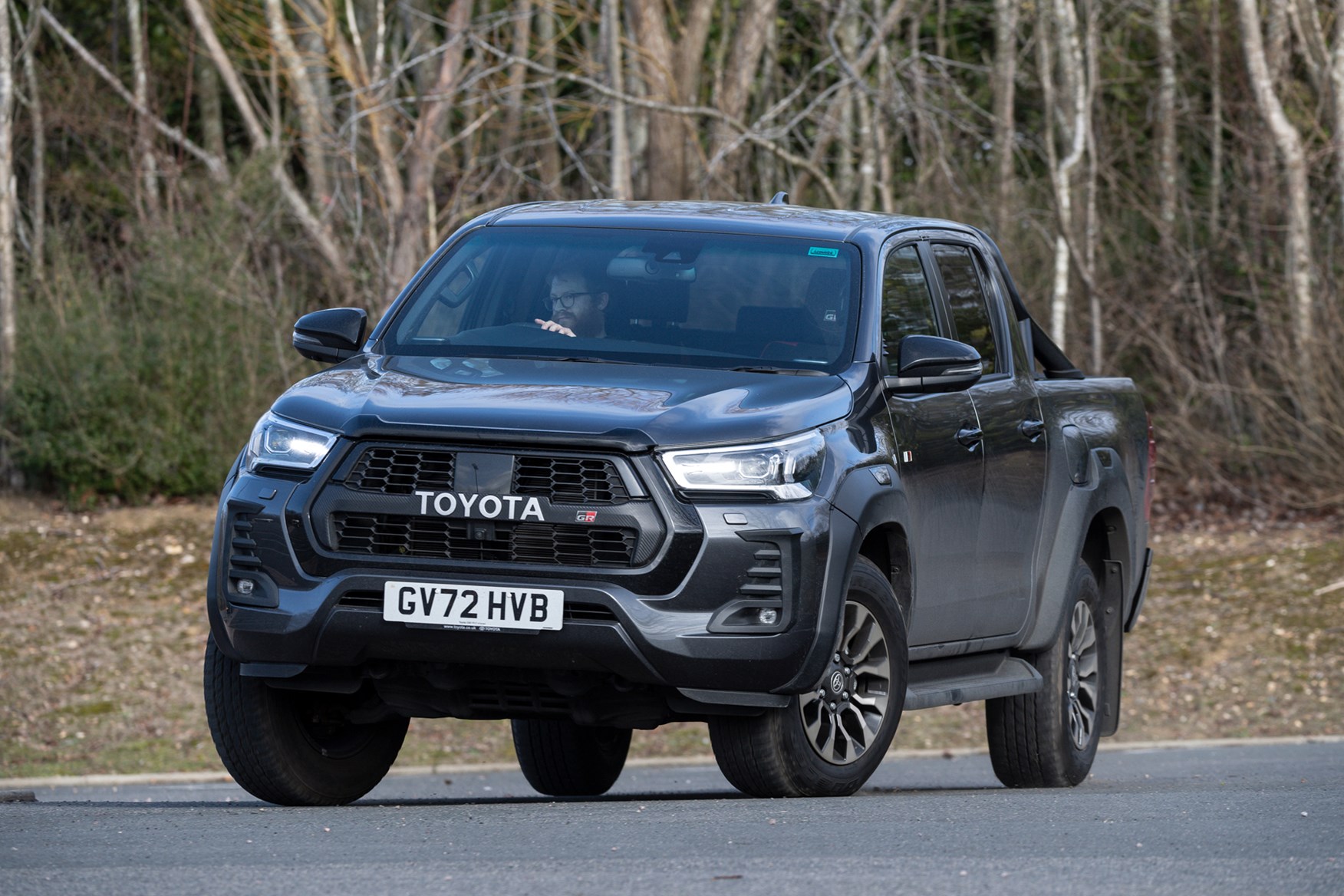
If you are jumping into the GR Sport expecting a totally different experience in terms of ride quality then we don’t have great news for you unfortunately. The ride certainly isn’t much smoother than the standard model, likely down to those stiffer front springs.
Instead, given the claimed faster response rate, the GR Sport feels set up for flying down tracks or across fields in greater comfort. With the best will in the world, this is not a day-to-day occurrence so the majority of the time you won’t feel the benefit. Granted this is a similar approach taken by the Ford Ranger Raptor, but that is a very different beast, and offers enhanced ride comfort when you’re on the road too.
How much does the Toyota Hilux GR Sport cost and should I buy one?
We love the Toyota Hilux, and think that the more powerful engines and well-equipped trim levels only add to its appeal. The GR Sport feels like a slight step too far though.
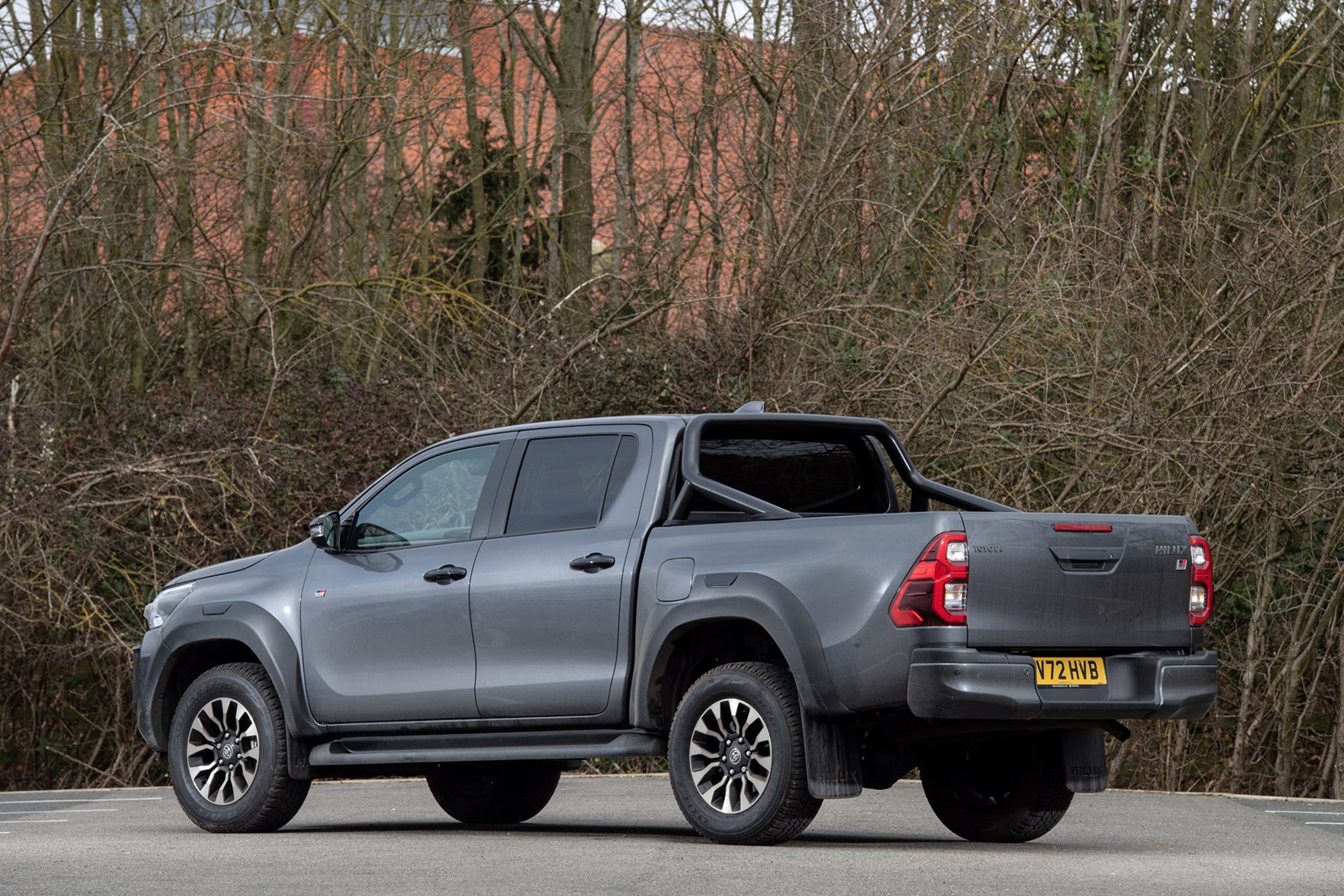
In the grand scheme of things it is not a huge step up in terms of price versus the previous range topper, the Invincible X, but you don’t necessarily get a better vehicle – the Invincible X is a great truck.
Pricing is set at £40,891, which is just over £1,800 more than the Invincible X. With a sensible head on it is hard to justify the upgrade.
Toyota Hilux Invincible X 2.8D manual review
Tested May 2021 by Tom Wiltshire
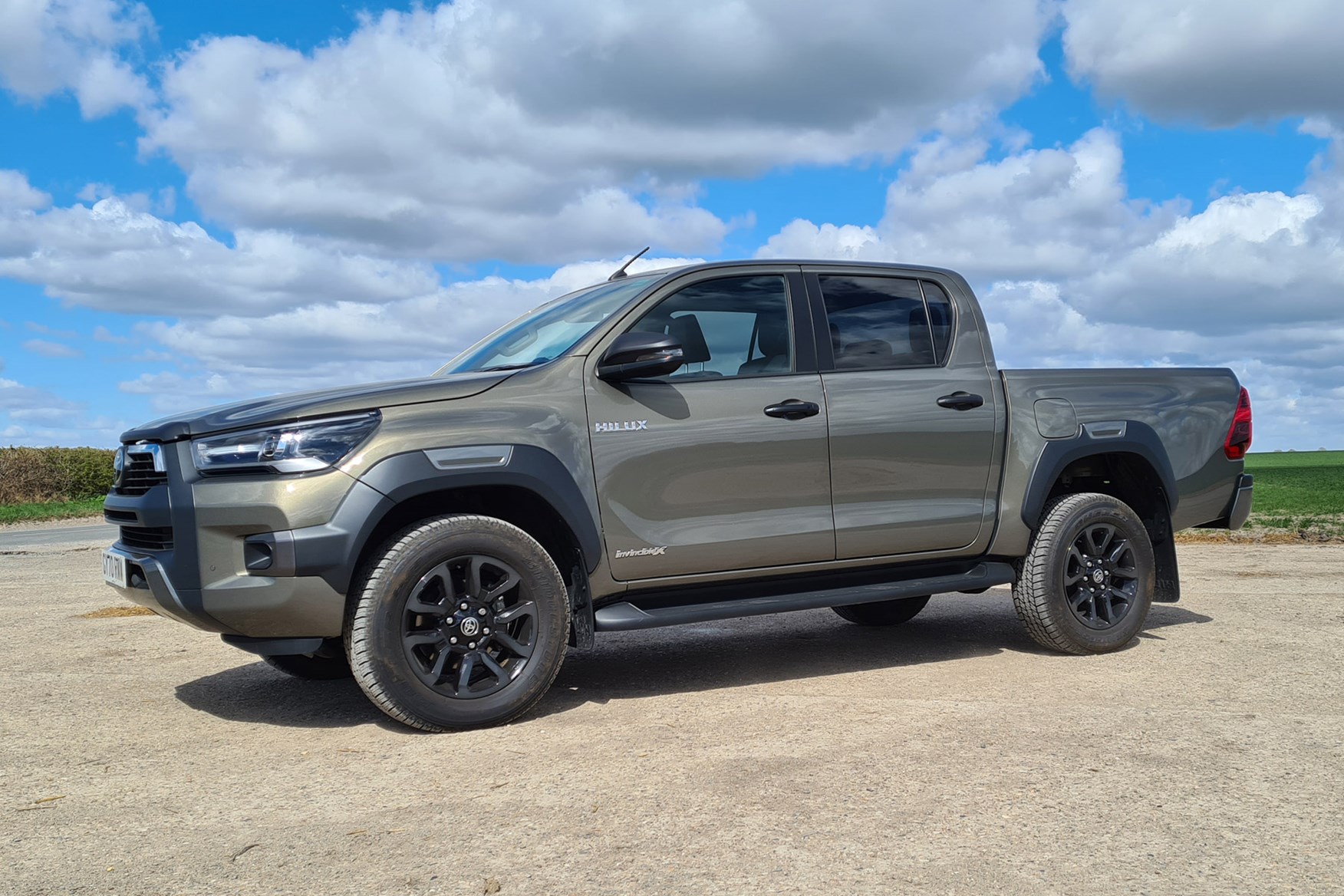
- Range-topping Hilux 2.8D tested
- Bespoke look and beefy new engine
- But a manual gearbox as standard
The Hilux remains strong and stable in a pickup market that’s dwindling in variety. Soon Toyota will only have the Ford Ranger, Isuzu D-Max and SsangYong Musso to compete with for sales, but these are all tough rivals in their own ways.
But recently updated with a particularly beefy 2.8-litre engine, the Hilux entered 2021 with a new lease of life – and we’ve tested the range-topping Invincible X to see if the changes have had much of an effect.
What’s changed in the facelifted Hilux?
Well, there was a refreshed look across the range, giving the Hilux a new face that while not exactly attractive is at least bold. The main change is a huge trapezoidal grille, while depending on the trim level you also get new LED lights front and rear plus a variety of new alloy wheels.
There’s a new 2.8-litre diesel engine – more on that lower down – plus a range of chassis and suspension mods that aim to improve the truck’s handling both on and off the road.
What’s different about the Invincible X?
Invincible X is the top of the range, and the most expensive model, excluding special editions and the more bespoke Arctic Trucks examples.
It gets a look that’s all its own, with a unique front bumper, grille and underbody skid plate, plus over-fenders for the wheel arches and a bespoke tailgate. Plus 18-inch alloy wheels.
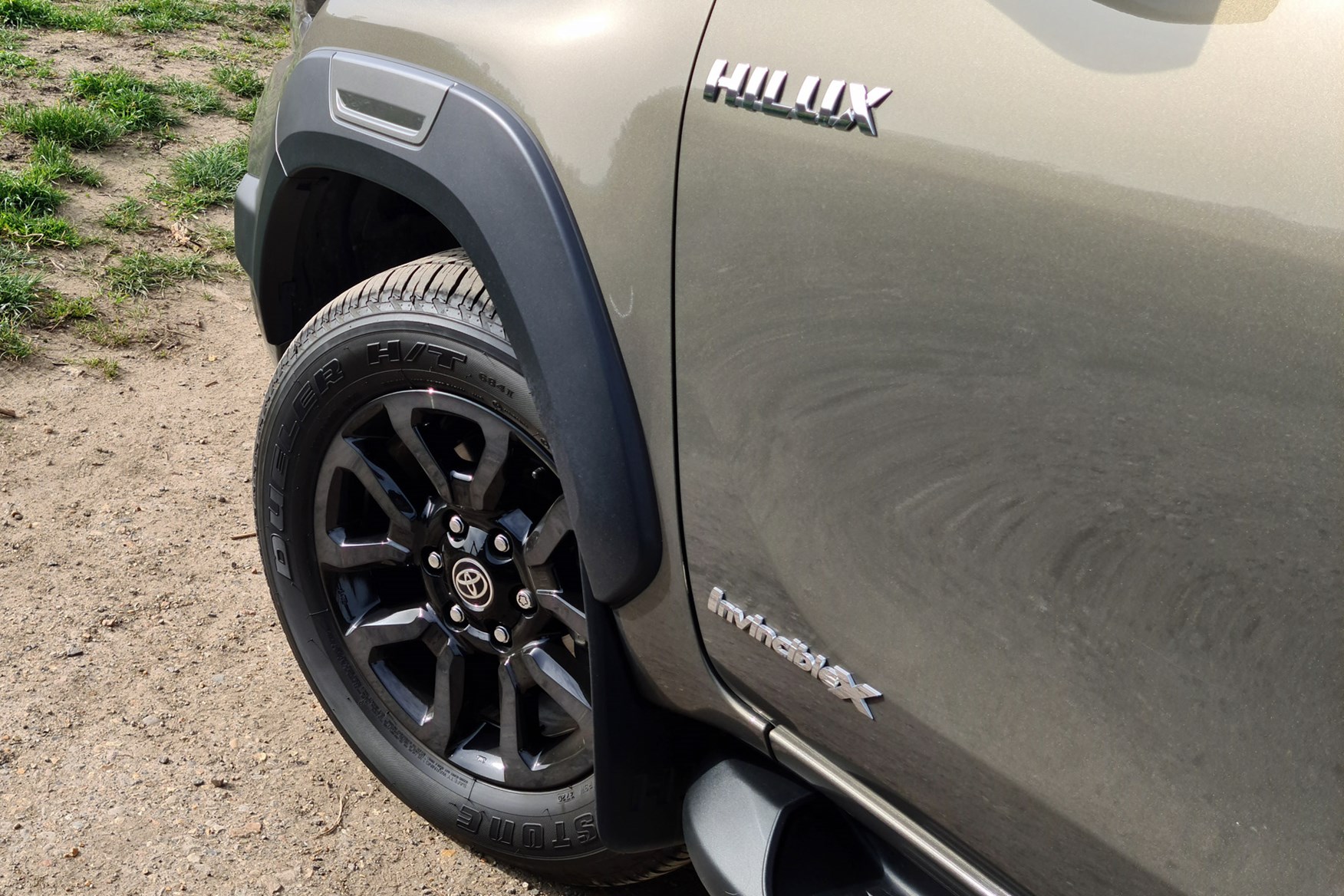
As the priciest Hilux it’s also the best-equipped – coming standard with Toyota’s touchscreen infotainment system with built-in sat-nav as well as Apple CarPlay and Android Auto. There’s ambient lighting for the interior, leather upholstery, and a high-end JBL sound system that does a pretty good job of drowning out the engine.
What about that engine, then?
The new 204hp 2.8-litre engine feels like the unit that this Hilux should have had from the beginning. The old 2.4-litre (which continues in lower-spec models) always felt muscular at the low end but ran out of puff at higher speeds, making it great for hard work on a farm or a building site but less ideal for long motorway runs.
With most double-cab pickups performing double-duty as family cars, on-road manners are every bit as important as off-road capability. And that’s where the additional punch of the new engine makes itself best-known. It feels very muscular indeed – not outright fast, like the old V6 VW Amarok or Mercedes-Benz X-Class did – but with more than enough in the mid-range to make merging onto fast-moving roads effortless and to give it a surprising turn of pace off the line.
It’s not a quiet engine, but that’s not really to be expected when 2.8-litres of capacity is shared among a mere four cylinders. However, it settles down to a refined grumble at speed, and though there’s a degree of vibration through the gear lever and pedals at idle it disappears when you’re underway.
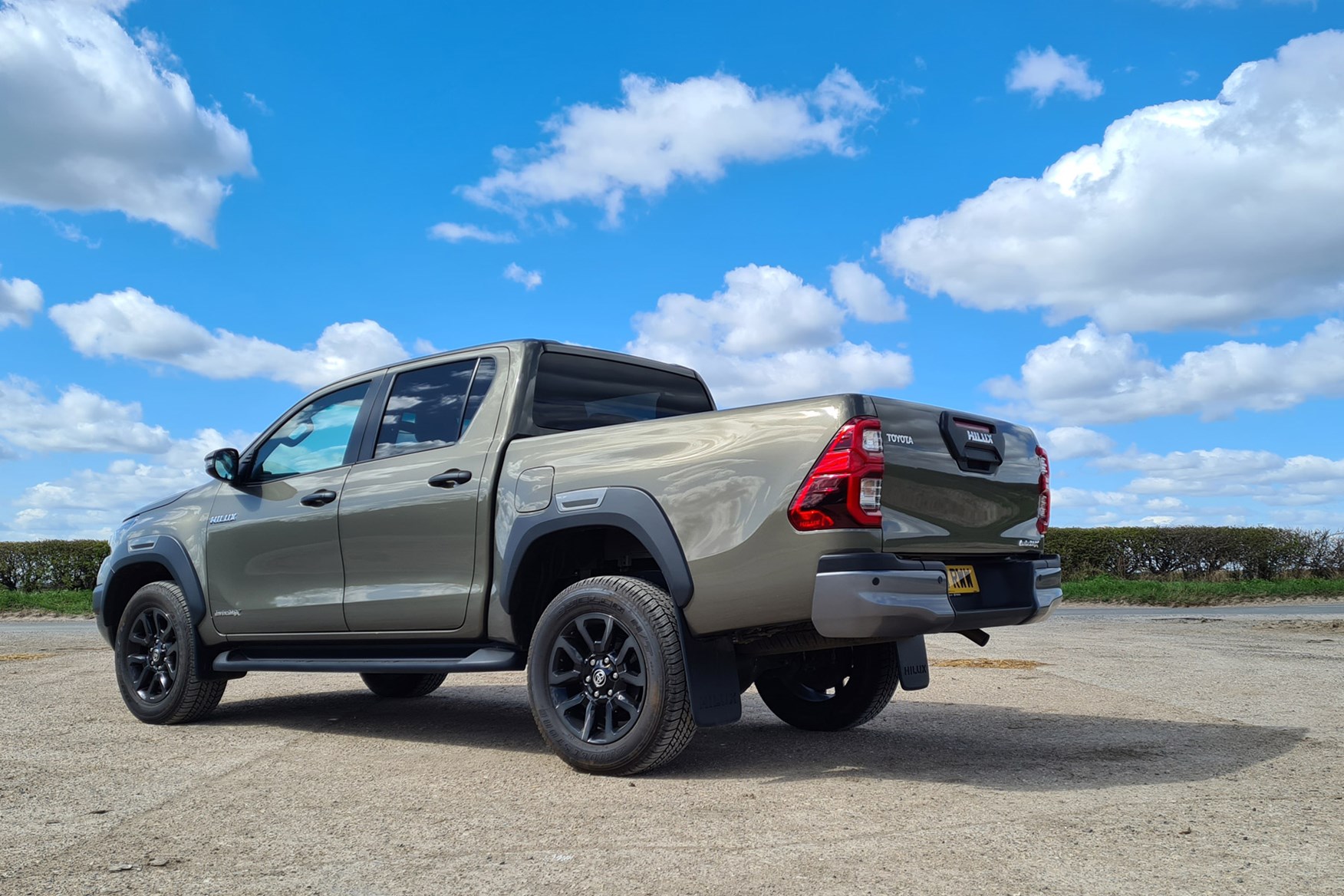
Speaking of the gear lever, we tested the six-speed manual model. This actually has reduced torque compared with the automatic, with 420Nm versus 500Nm, so despite being a useful degree cheaper (£1,500 at the time of writing) it wouldn’t be our choice.
The manual also suffers with quite a high clutch, making it a bit of an exercise in frustration in slow-moving traffic. That’s in addition to a huge slug of torque right from standstill, which no doubt makes getting a trailer moving effortless but also means it’s quite difficult to set off smoothly when you’re not loaded.
The six-speed auto is slightly slower (0-62mph in 10.7 seconds, versus 10.1 in the manual) but for the more relaxing drive it would be our preferred option.
Still, even with the added capacity and power, the new engine is barely any less efficient than the old 2.4. On a long run of mostly A-roads and motorways we found it displaying around 33mpg, which is right at the top end of the official WLTP figures. This was lightly loaded, however – expect lower figures if you’re making use of the truck's full payload capacity or towing.
How does it handle?
Reassuringly well for a big, heavy vehicle. The Hilux feels a bit more commercial than the very car-like Ford Ranger, but generally speaking it’s comfortable, especially once you get up to speed.
There’s some bouncing and lumpiness to the initial ride that can be felt around town, though, making it feel harsh at low speeds.
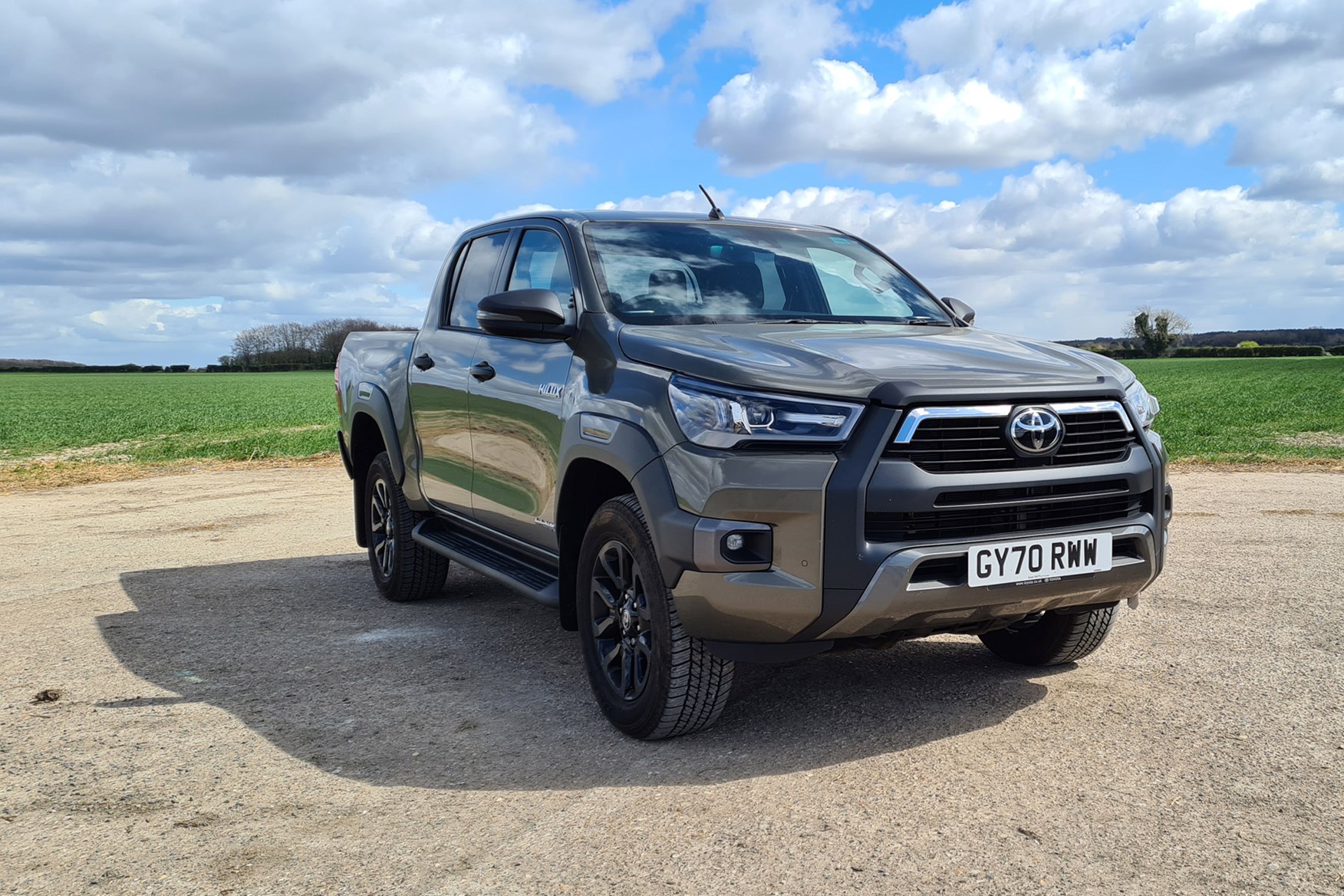
Despite improvements for the facelift, the steering is still rather slow and not geared towards fast cornering, but the front end doesn’t feel at all vague. It’s only bested by the Ford Ranger in this regard.
What’s the cabin like?
Our Invincible X model made a good first impression with its comfortable yet hardwearing leather upholstery and electrically-adjustable driver’s seat. Our 6’2 tester did need the seat in its rearmost position, though, so make sure you take a long test drive if you’re particularly long in the leg, in case you can't get comfortable.
The Invincible X comes with Toyota’s latest Touch 2 infotainment system, which includes a built-in sat-nav. Unfortunately this is still a ways behind the competition in terms of ease-of-use, with unattractive, labyrinthine menu systems and a touchscreen that looks dim and low-res, and feels unresponsive compared to the best.
The built-in nav is fairly poor, too, proving ineffective at routing around traffic jams. Luckily, Toyota has finally seen sense and included both Apple CarPlay and Android Auto connectivity, which allow you to plug your smartphone into the USB port and let it power navigation, music and media, and telephony. We suspect this is how most owners will use it.
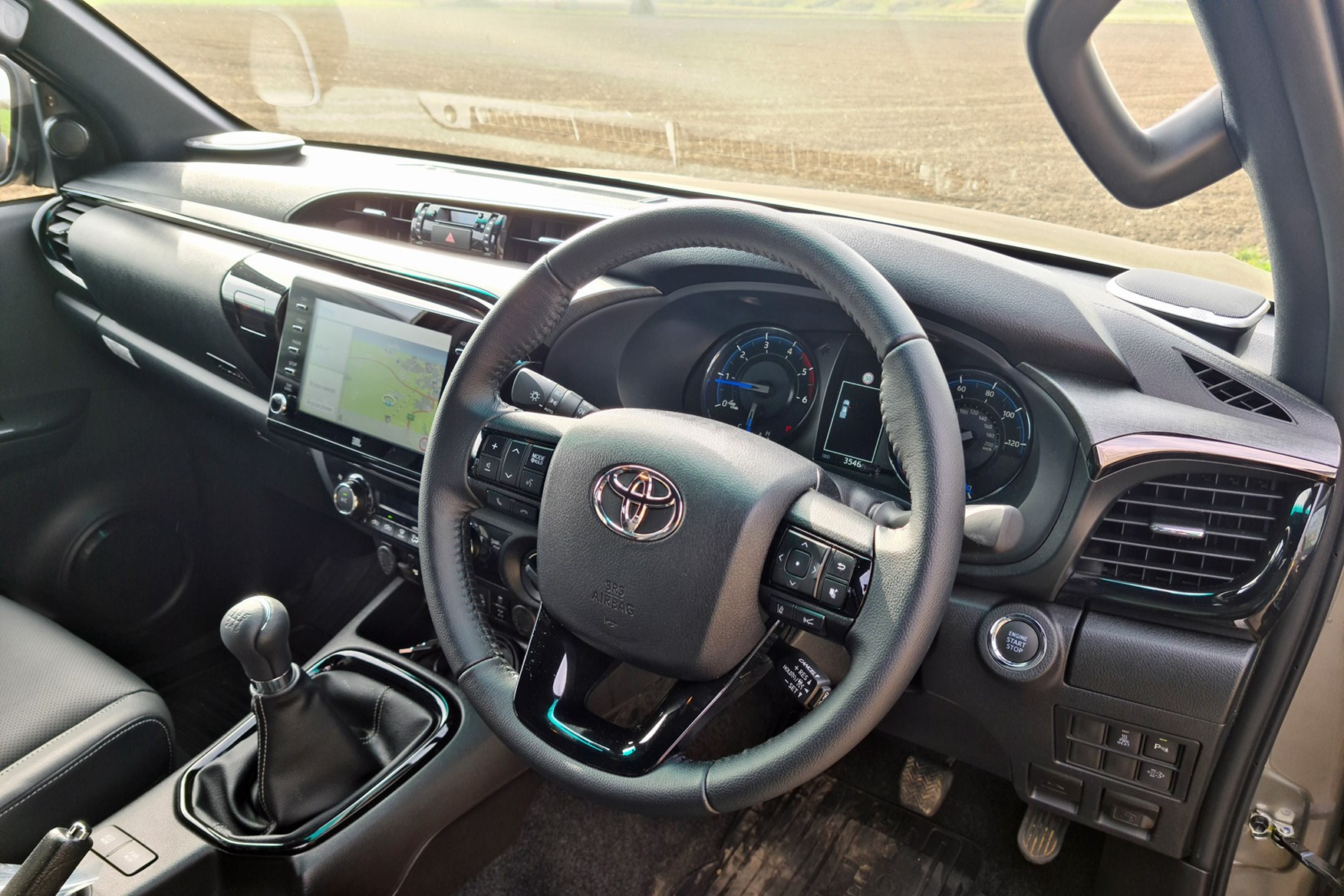
They’ll be able to take advantage of the rather excellent nine-speaker JBL sound system, which has more than enough boom in it to drown out the wind and road noise you get in a bluff-fronted pickup.
Otherwise, build quality is excellent throughout, and the controls are largely well-sited and chunky enough to easily press on the move or while wearing gloves. An exception are the steering wheel buttons, which are rather crowded, and the awkward cruise control stalk.
The twin gloveboxes are a nice touch but the manual model lacks a secure spot to hold a smartphone, while the door bins are a bit pokey, too. There’s also only a single cupholder as opposed to the twin cupholder you get in the auto. Rear legroom is only average but the doors of the double-cab model open wide enough to make access fairly simple.
How much does the Toyota Hilux Invincible X cost and should I buy one?
It’s a big truck with a big price tag, and arguably Invincible X trim is only a cosmetic upgrade, Certainly equipment-wise most people would be happy with the plain Invincible or even the Icon, though the latter does miss out on LED headlights and is stuck with the 150hp 2.4-litre engine.
The X is even more expensive when you consider our recommended automatic gearbox adds a further £1,500 to the price tag, leaving the total at a chunky £41,195 (£39,695 for our manual model).
If you can do without the stylish additions or fancy stereo, you’ll save a useful chunk of cash – the Invincible is just over £4,000 cheaper than the X. That’s probably the sweet spot of the range. But you wouldn’t be judged for paying the extra for the Invincible X’s badass looks.
Toyota Hilux Invincible 50 review
Tested March 2019 by CJ Hubbard
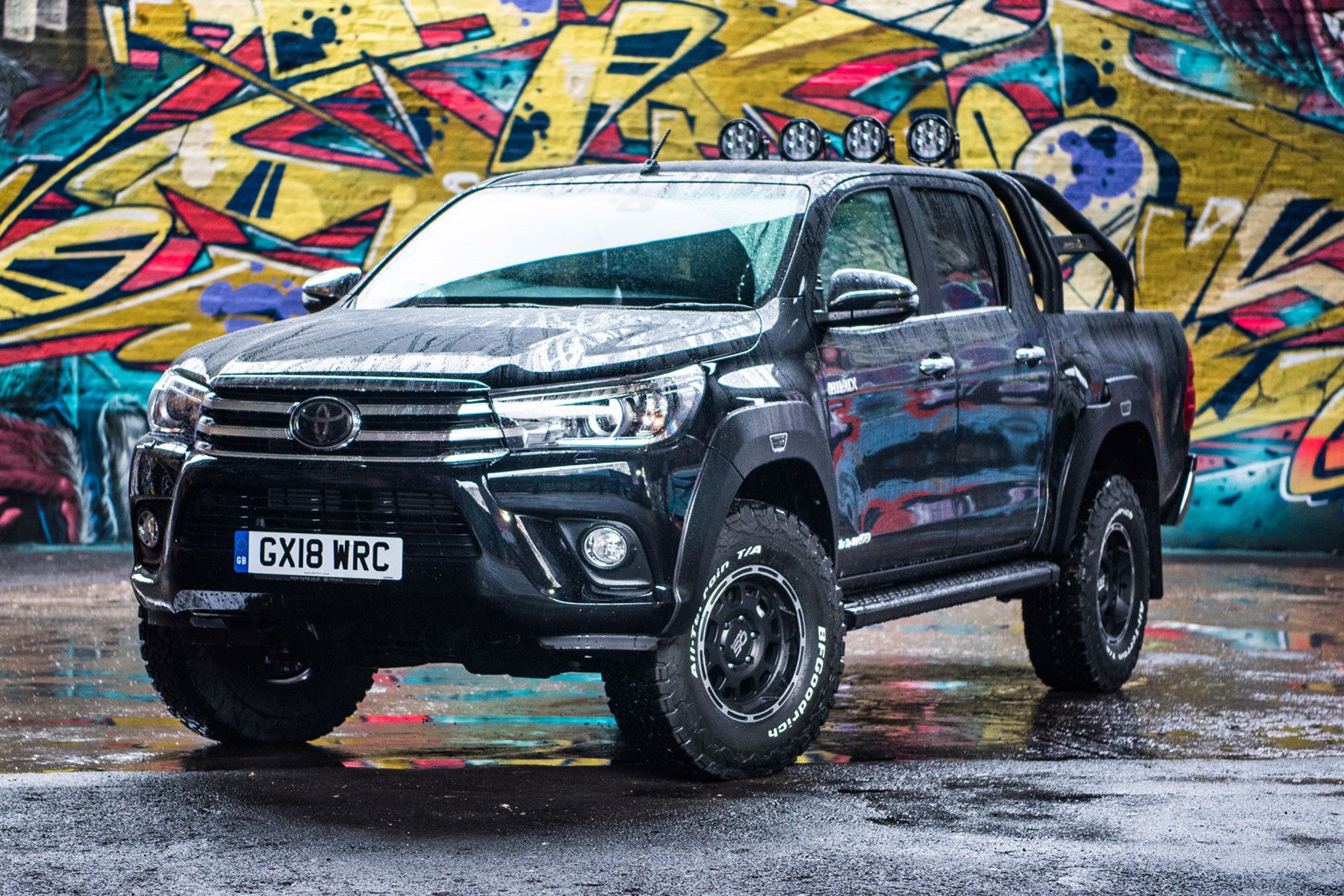
- Limited edition celebrates 50 years of Hilux
- Arctic Trucks suspension and bodywork mods
- Great looks – but how’s the performance?
Say whatever you like about the limited power output of the engine, Toyota can sure turn out a mean-looking version of the Hilux when it puts its mind to it.
The version we’re driving here is pretty special, however – a limited edition called the Invincible 50, it celebrates 50 years since the Hilux first went on sale, and has been put together in partnership with Arctic Trucks.
What’s special about the Hilux Invincible 50?
Just look at it. Finished exclusively in metallic black, the Invincible 50 is based on the regular Hilux Invincible double cab model, but festooned with unique additional detailing to make it stand out.
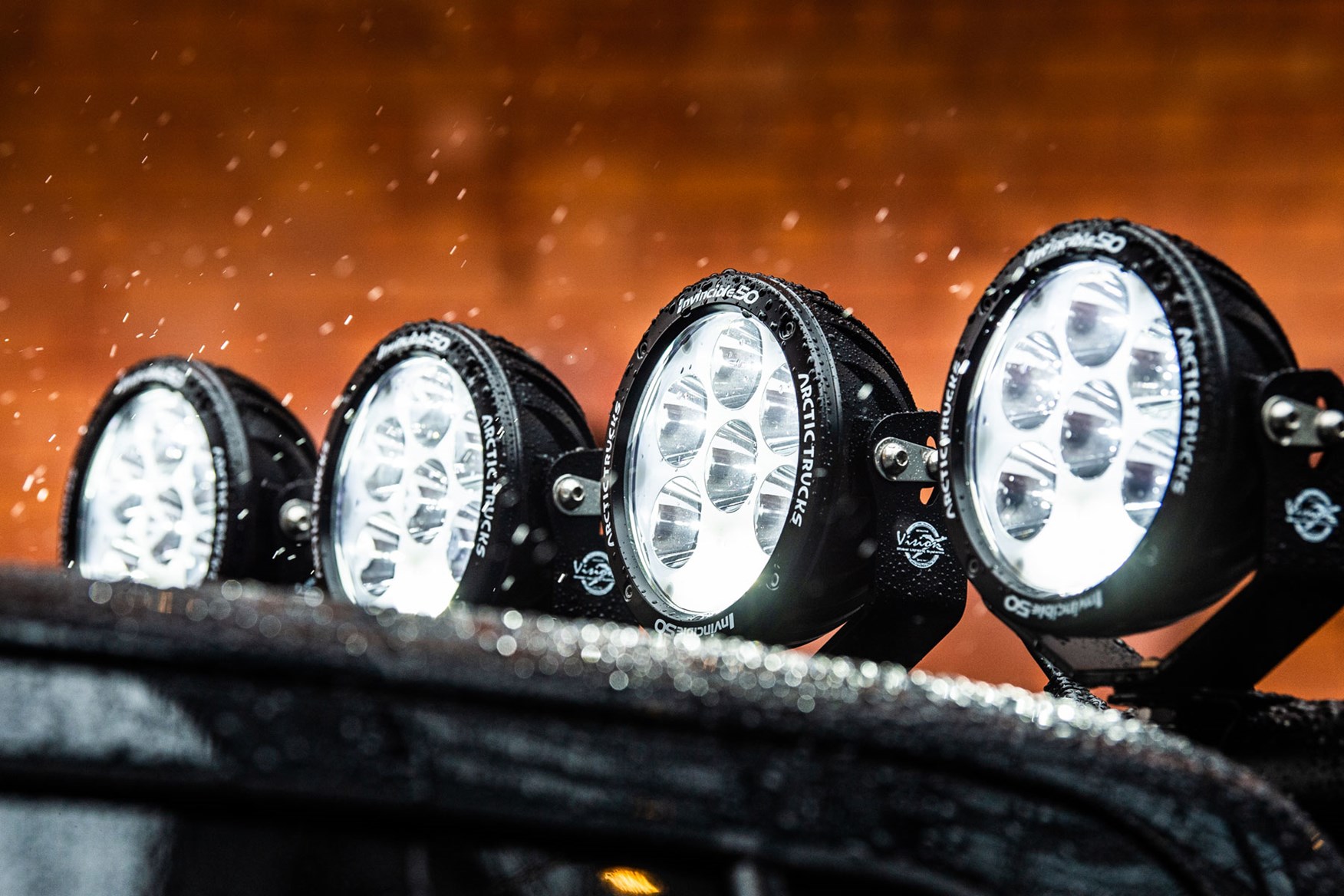
Most obvious are the four multi-LED spotlights mounted on the double-hoop sports bar behind the roof, but the 16-inch satin-black alloy wheels are bespoke to this model, too, as are the BF Goodrich all-terrain tyres.
Less immediately apparent from a distance are the enlarged wheel arches and raised suspension – both the work of Arctic Trucks, using Bilstein high-performance shock-absorbers – but once you get up close it’s clear this Hilux stands taller than regular models in the range.
Either way, it’s not hard to be certain it’s an Invincible 50 you’re looking at, as the thing is absolutely covered with Invincible 50 badging; from each of the spotlight surrounds to the alloy wheel centre caps to the numbered plaque on the centre console and the badges all over the exterior, the logo is everywhere.
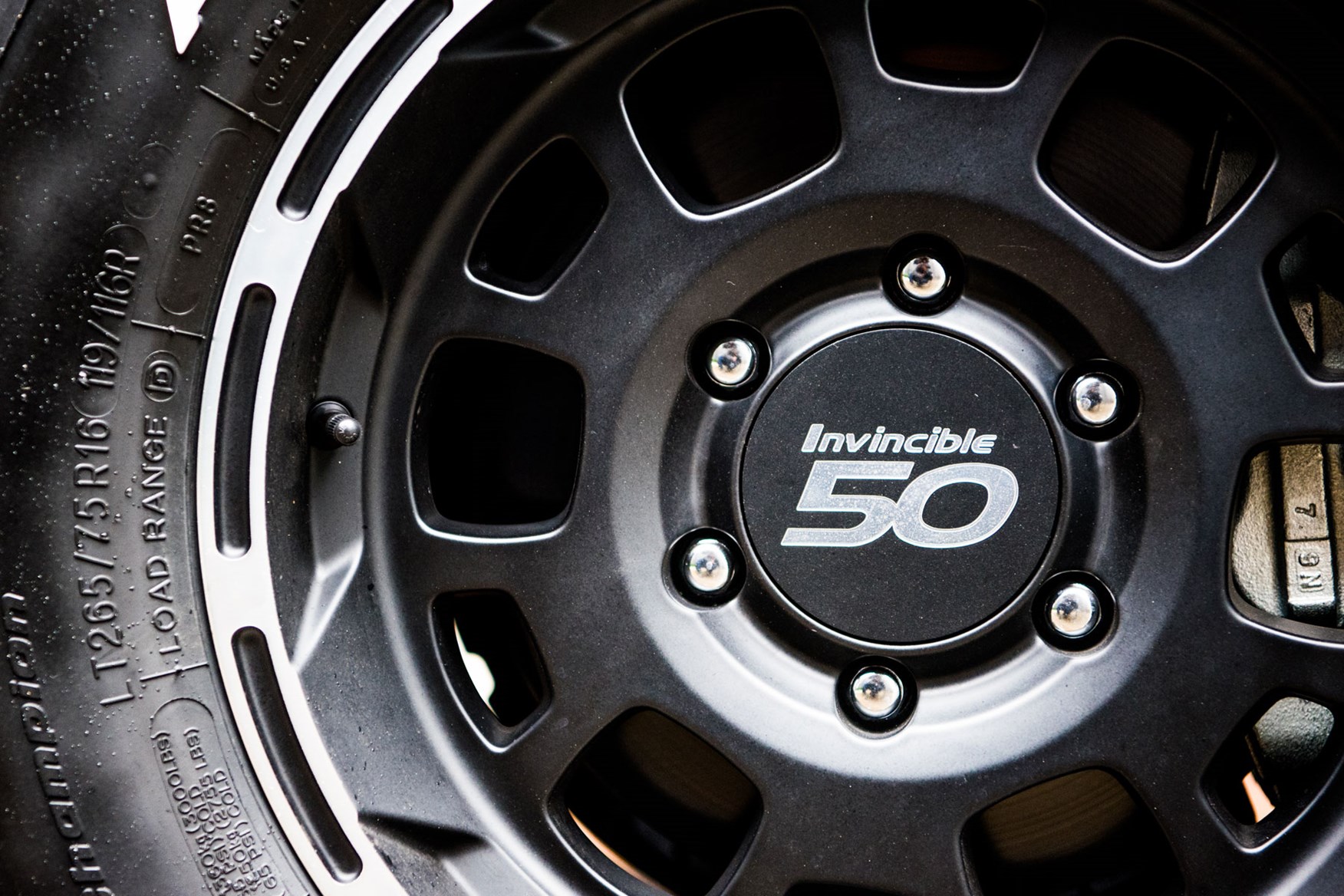
Buyers also get a bed liner, Arctic Trucks mud flaps, rear parking sensors and – perhaps most important of all – retro-style Toyota tailgate lettering.
What kind of Arctic Trucks conversion is fitted to the Invincible 50?
In 2018, Toyota began selling Hilux AT35 Arctic Trucks conversions direct from its dealership (see our drive of the Hilux Bruiser show car for an example of what this is like) – but it turns out the Invincible 50 isn’t one of these.
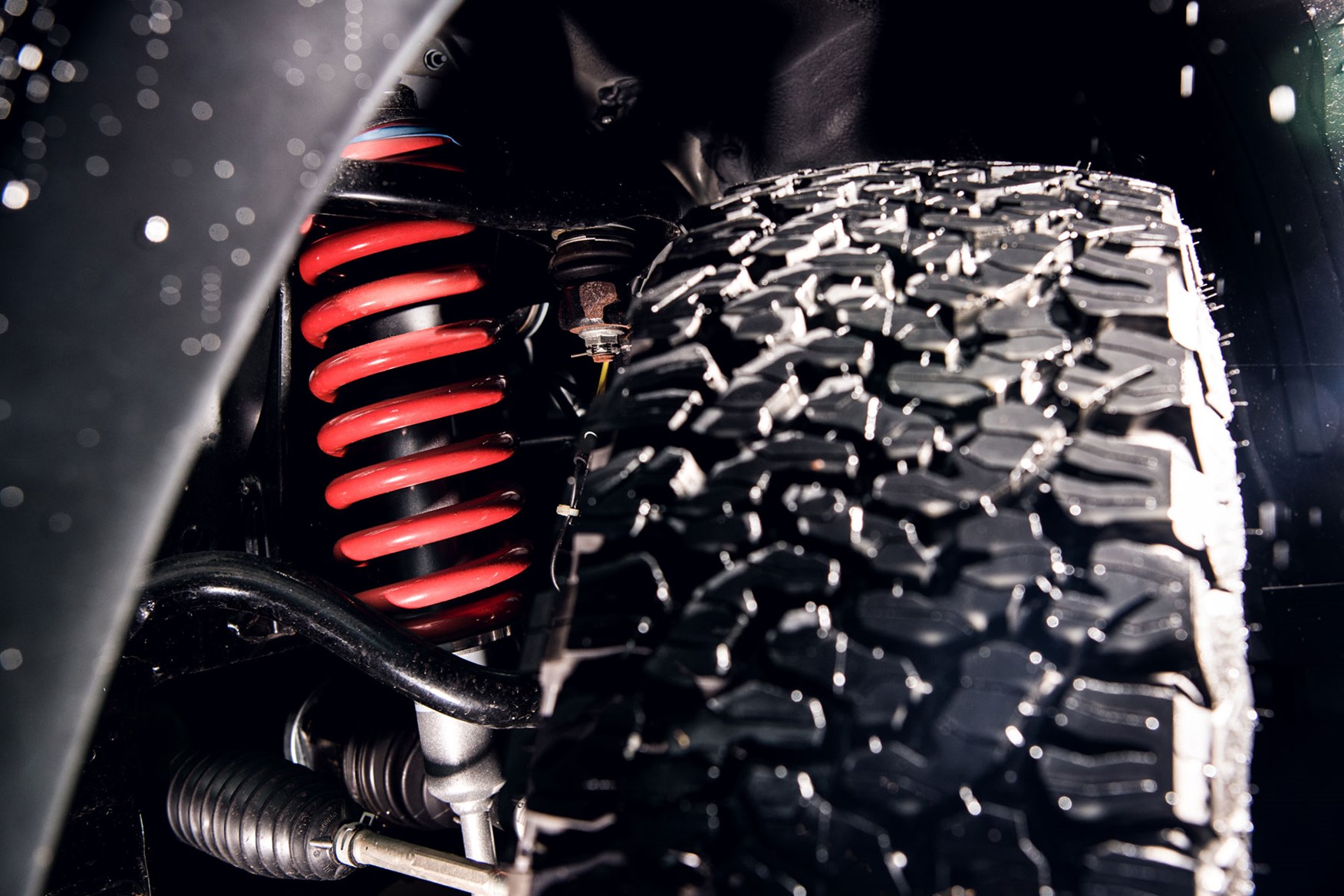
Instead, although Toyota doesn’t say so explicitly, it is in fact a slightly more subtle AT32 conversion, similar to the one available on the Nissan Navara.
This means the Invincible 50 features smaller wheels and a less extreme suspension lift, and requires only modest wheel arch extensions – though these still look good, and neatly feature a badge telling you the tyre pressures, which looks suitably bad ass even when parked outside a supermarket.
And although it isn’t as extreme as the AT35, the suspension is still raised 40mm at the front and 20mm at the rear, resulting in increased axle articulation and improved approach and departure angles.
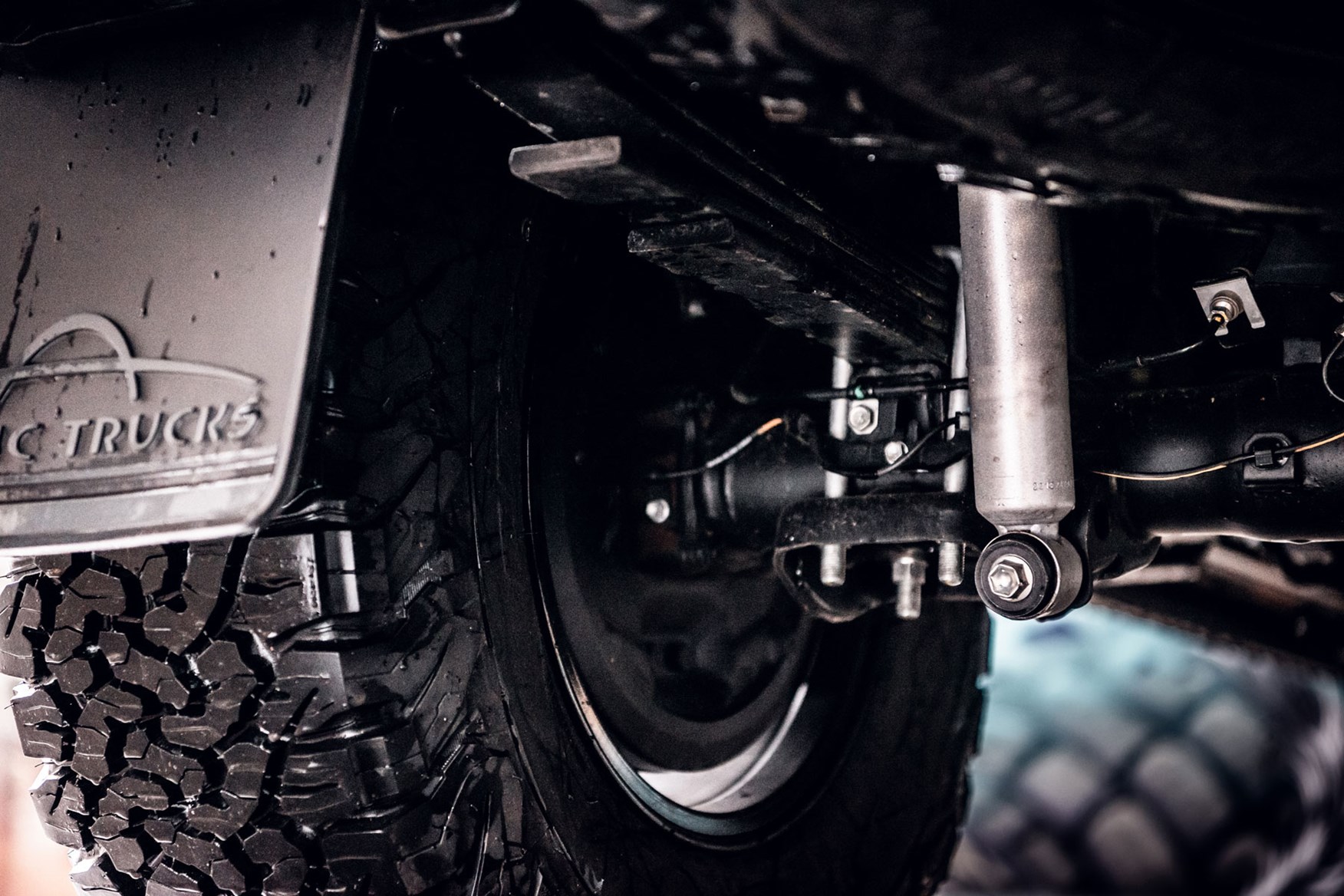
Put this together with the Hilux’s standard-fit four-wheel drive system and you’ll be able to tackle some pretty challenging off-road obstacles without too much difficulty.
What’s the Invincible 50 like to drive?
As is often the case with pickups that have been given the Arctic Trucks treatment, it’s an improvement over the standard product in some respects but doesn’t help the Hilux’s weakest area.
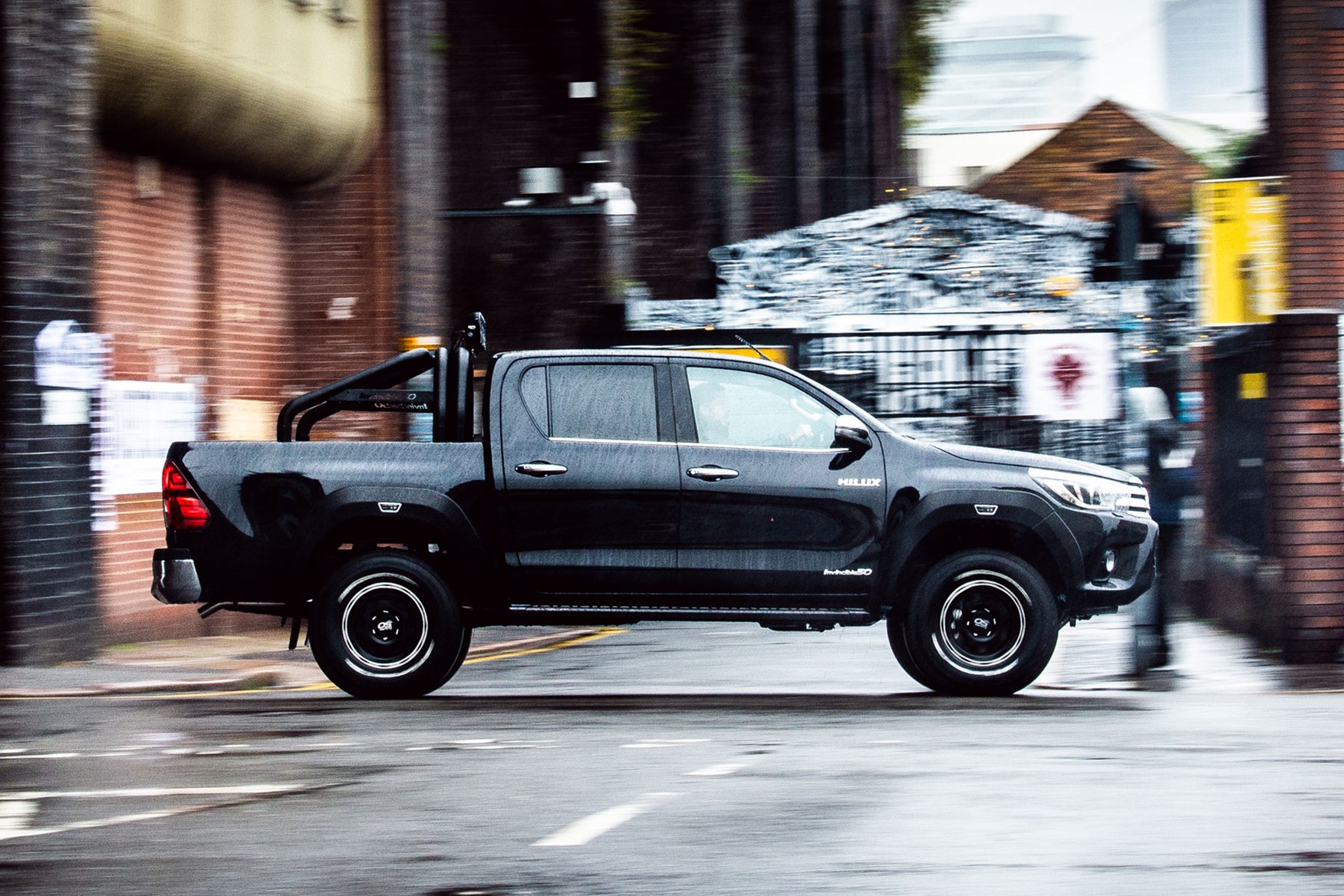
The Bilstein dampers aren’t super squishy, so the 50 still feels a little firm – compared with a regular car – but does have less of the usual jittery you get from a pickup. It retains its composure in the corners and feels, well, invincible when faced with a bit of light green laning.
The increased ground clearance may be modest, but with all the other accessories it stands tall enough that other road users give you plenty of respect – if you’re after a pickup with an imposing appearance, you could do a lot worse than this one.
The only real issue for us is the lack of outright power. There’s enough torque – 400Nm 1,600-2,000rpm – to get the truck rolling, but acceleration is not impressive on the standard truck. The larger, heavier wheels of the Invincible 50 only make this worse.
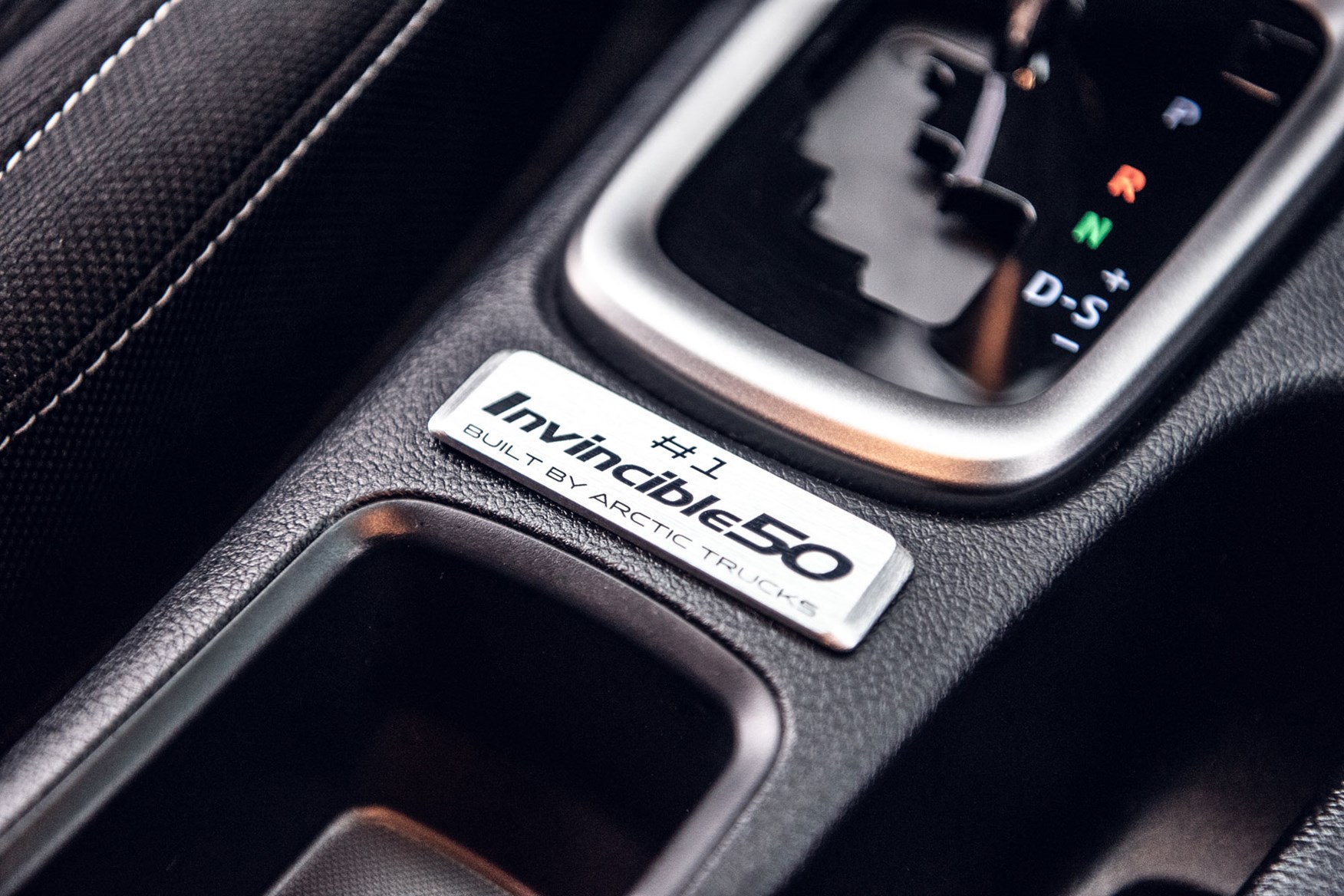
Still, you do get the six-speed automatic transmission as part of the package, so at least you don’t have to stir the manual gearbox to encourage this Hilux to get up and go.
Any changes on the inside?
Aside from the numbered plaque it’s standard Hilux Invincible inside. Full details of standard kit are listed in the main review above.
How much does the Toyota Hilux Invincible 50 cost and should I buy one?
Limited to just 50 examples, the on-the-road VAT inclusive price is £39,995 – around £2,700 more than the next most expensive Hilux. Not a bad deal for the exclusivity and the extra kit.
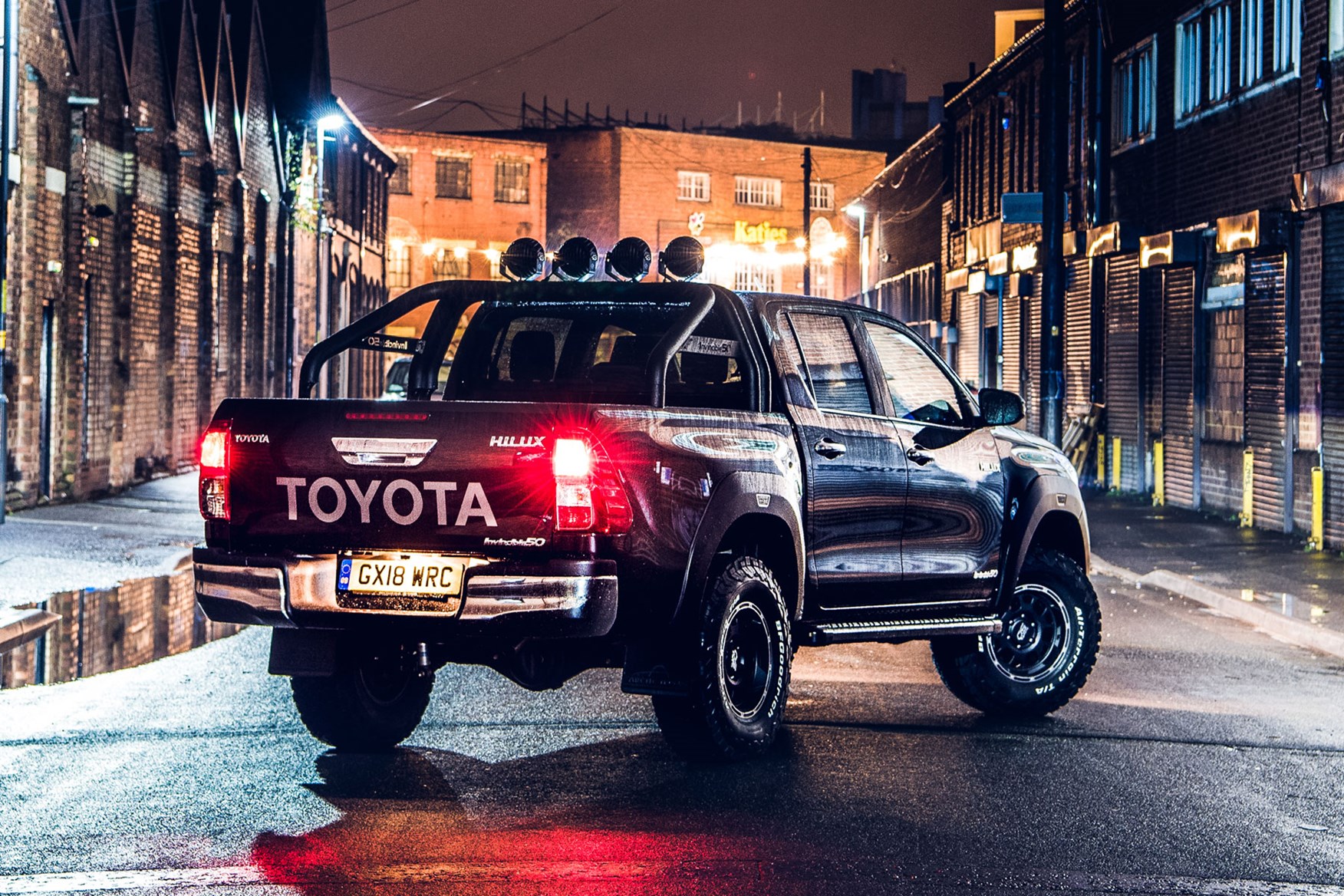
The price excluding VAT is £33,329.
You could buy a V6-powered VW Amarok for similar cash and get a lot more performance. But it wouldn’t look this good…
Toyota Hilux Invincible X automatic review
Tested February 2019 by CJ Hubbard
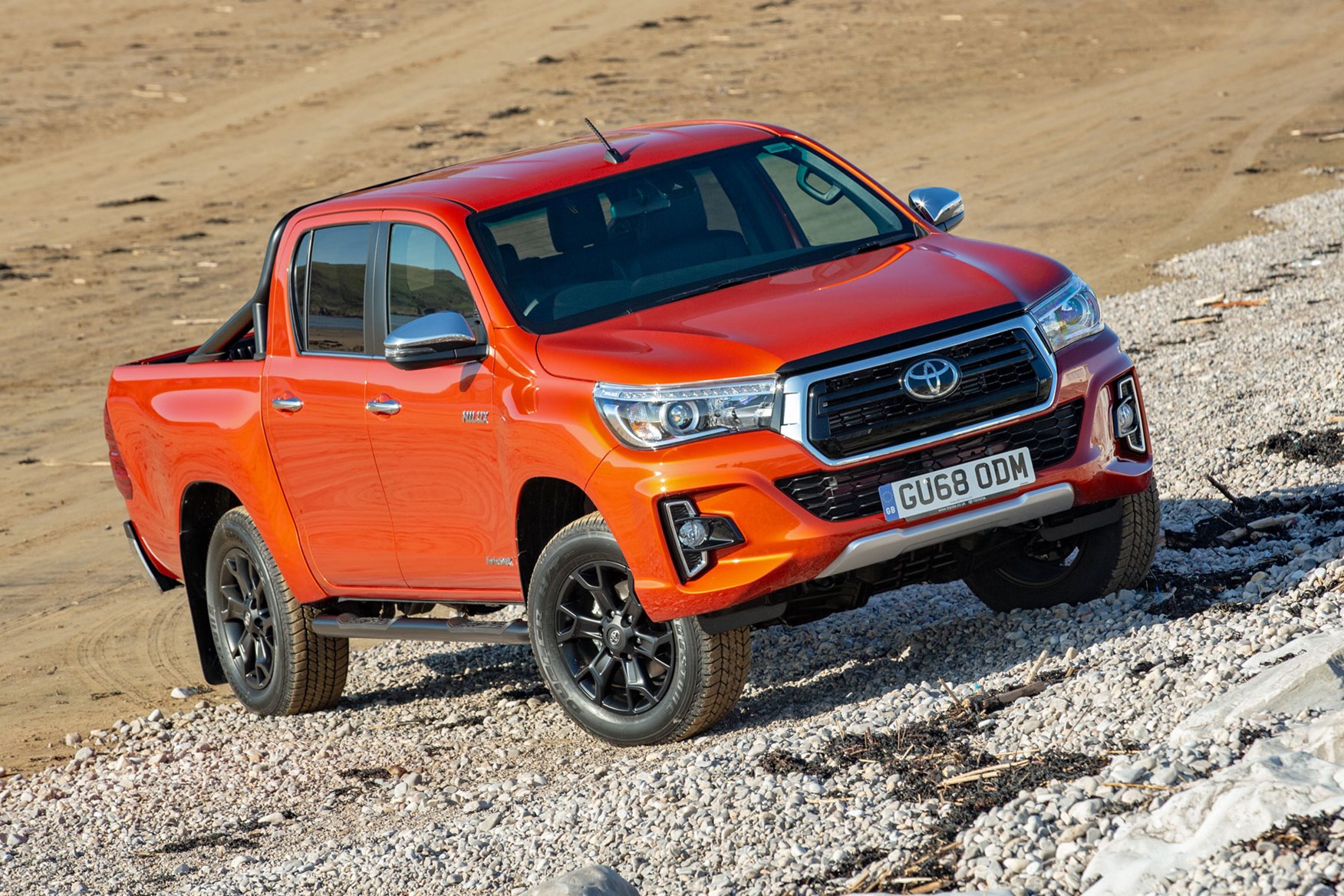
- Range-topping Hilux with unique front bumper
- Lots of standard kit including sat-nav and parking sensors
- Same 150hp 2.4-litre diesel; automatic gearbox only
The Toyota Hilux Invincible X sits at the very top of the standard Hilux pickup range. We have to insert ‘standard’ as a qualifier, as you can buy an Arctic Trucks modified Hilux direct from a Toyota dealer these days as well; the Hilux AT35 is more expensive than the Invincible X, but also a much more specialised purchase, with full-on off-road tyres, suspension and bodywork modification.
Unless you need this stuff, the Invincible X is a better choice, with loads of standard kit and a less fretful driving experience – which is to say, it fits down most city centre streets without making you involuntarily breathe in...
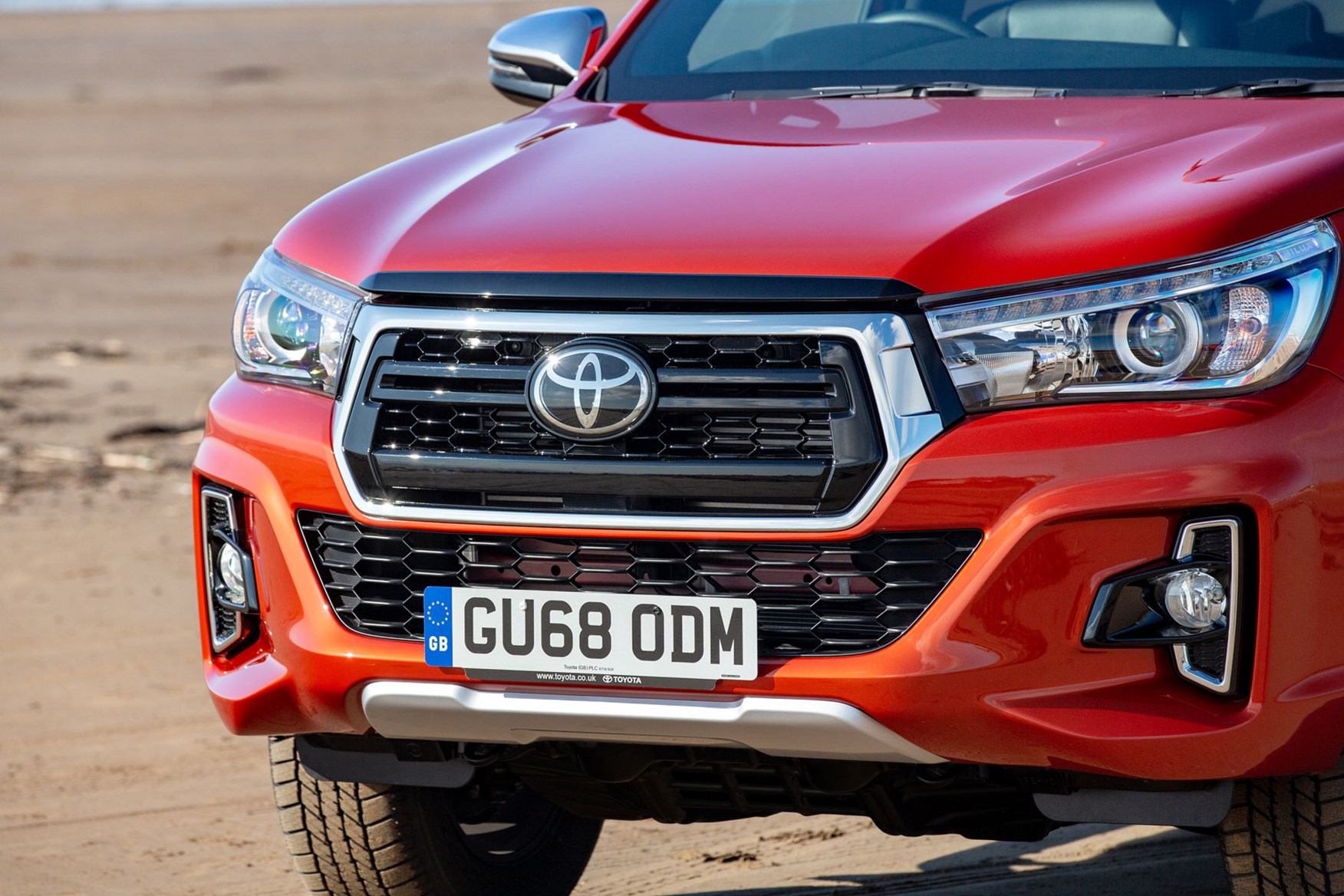
Besides, the Invincible X stands out in other ways. It’s the only Hilux to get this bluffer front bumper treatment for starters, somehow making the pickup look significantly more premium and bringing it further into line with the design of Toyota’s passenger cars.
Keeping this bumper just for the Invincible X, rather than facelifting the entire Hilux range, is a deliberate ploy to make the range-topper instantly identifiable. In other words: you’ve bought the best, and everyone will know it at a glance.
Aside from the bumper, what else is different about the Toyota Hilux Invincible X?
As the name suggests, the rest of the truck is largely based on the Hilux Invincible – but you do get a good amount of extra standard equipment.
For example, inside the cab – which is already among the most distinctive in the pickup sector, thanks to its tablet-style touchscreen – you get an all-singing, all-dancing sat-nav infotainment system, black leather upholstery and heated front seats complete with electric-adjustment on the driver’s side.
On the outside there are new chrome sidebars with integrated steps for front and rear passengers, a silver-coloured scuff plate up front, and parking sensors at the rear.
The Invincible X is also only available with the automatic gearbox; the regular Invincible can be bought with a manual transmission as well.
What’s the Hilux Invincible X like to drive?
There are no performance enhancements or suspension changes for the Invincible X, so this really is all about the looks.
As with every Hilux, the ride comfort is a pleasant surprise – like the VW Amarok, this is quietly remarkable given the use of leaf springs on the rear axle – and engine refinement is impressive. This is not a noisy truck.
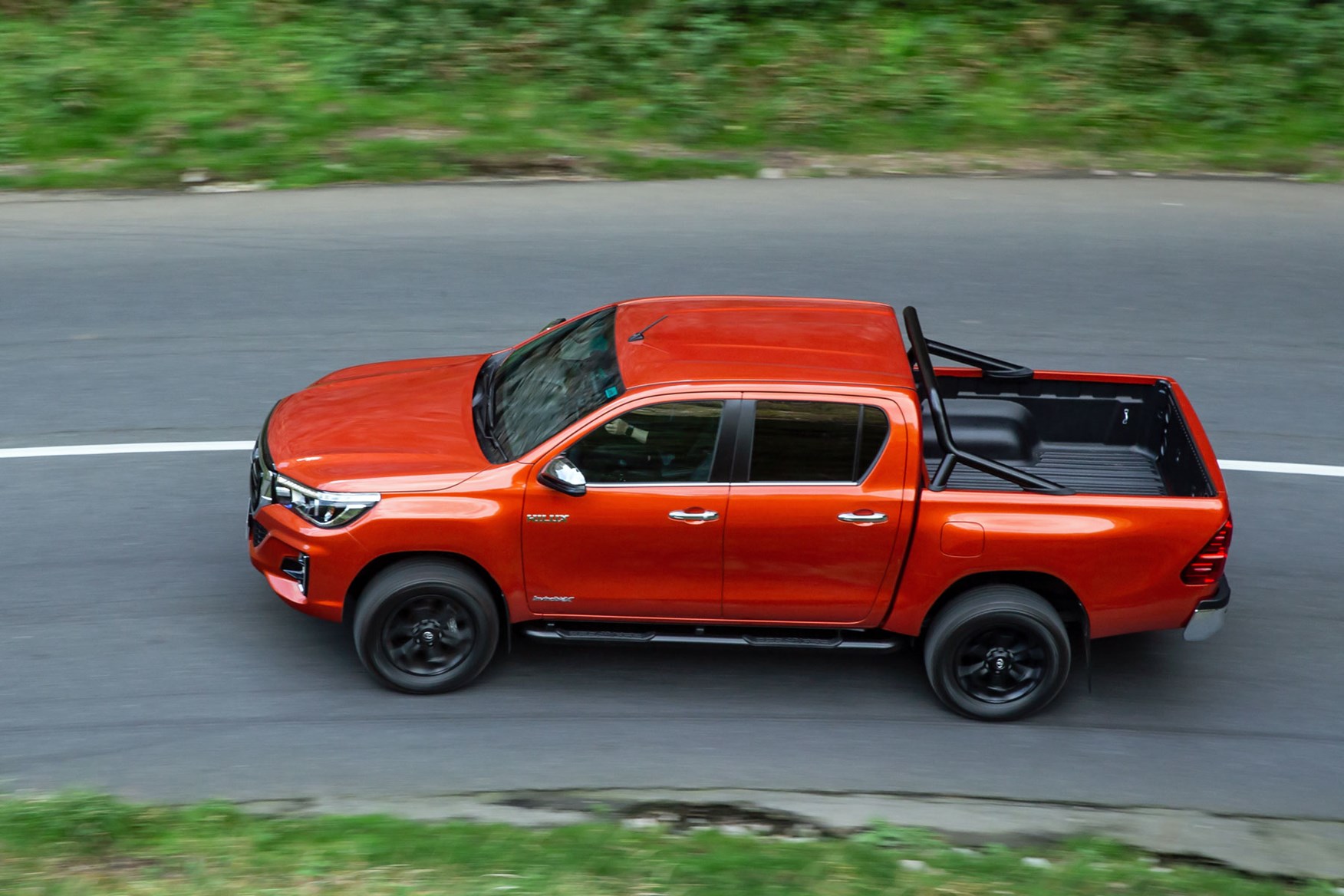
However, also as with every Hilux, this is not a fast vehicle. With just 150hp from its 2.4-litre turbodiesel, the Toyota is one of the least powerful pickups on sale now – and though it will still tow 3.5-tonnes, acceleration even unladen is decidedly leisurely.
And that’s despite the X’s standard-fit automatic gearbox shaving half a second off the official 0-62mph time; 12.3 seconds still isn’t very fast in a pickup world where 258hp V6 versions of the Amarok and the Mercedes-Benz X-Class exist.
This probably won’t be the best Hilux choice if you need to do off-roading, incidentally, as both the side steps and that new front bumper will reduce the pickup’s ability to clear obstacles.
Is the Toyota Hilux Invincible X good value?
At the time of writing, the difference between the X and the regular Invincible automatic is over £3,200 (excluding VAT). You’re really going to have to want that front bumper for it to be worth it, we feel, as that’s the only element that can’t be added to the standard Invincible via the options list.
And no shame if you do. The Invincible X certainly looks a more premium machine precisely because of that front end change.
Should I buy a Toyota Hilux Invincible X?
Want the best Hilux available for mostly on-road driving? Then the Invincible X is certainly it. We like the way it looks on the outside and in the cab, and certainly appreciate the quiet and comfortable way it drives.
As ever, the engine’s actual performance is a disappointment, however. Especially when you could get a 204hp Amarok V6 automatic (admittedly in a lower specification) and still have change from this Hilux’s £31,046 ex. VAT asking price.
All prices correct at time of writing.









































































